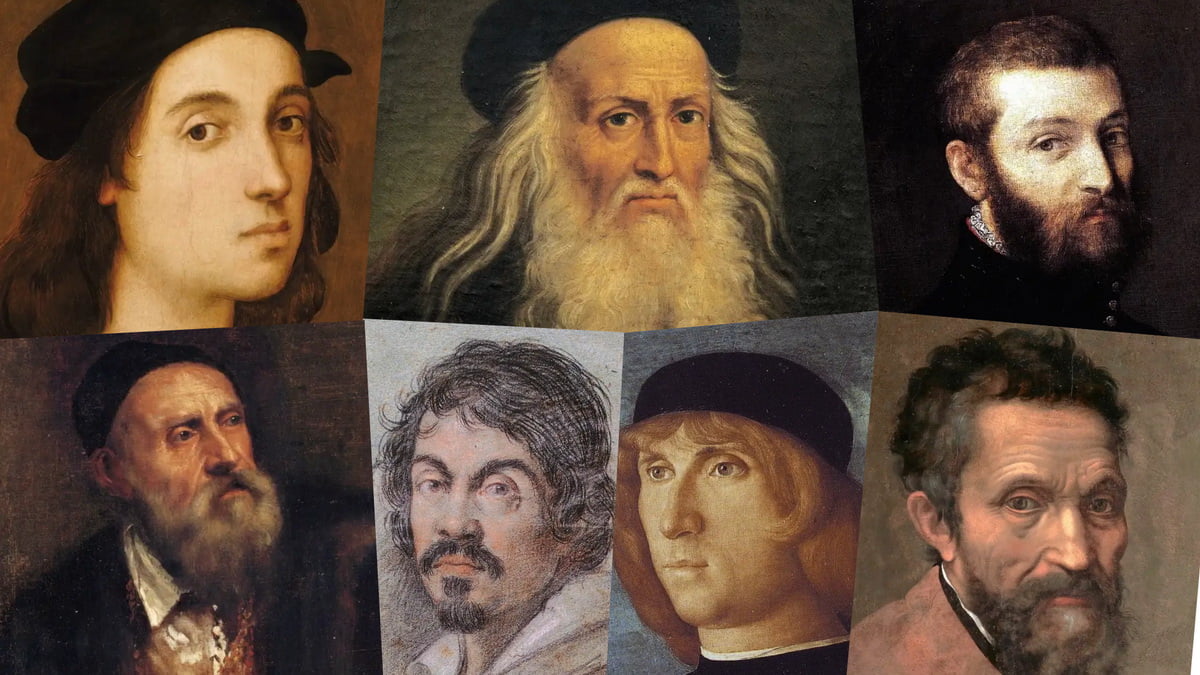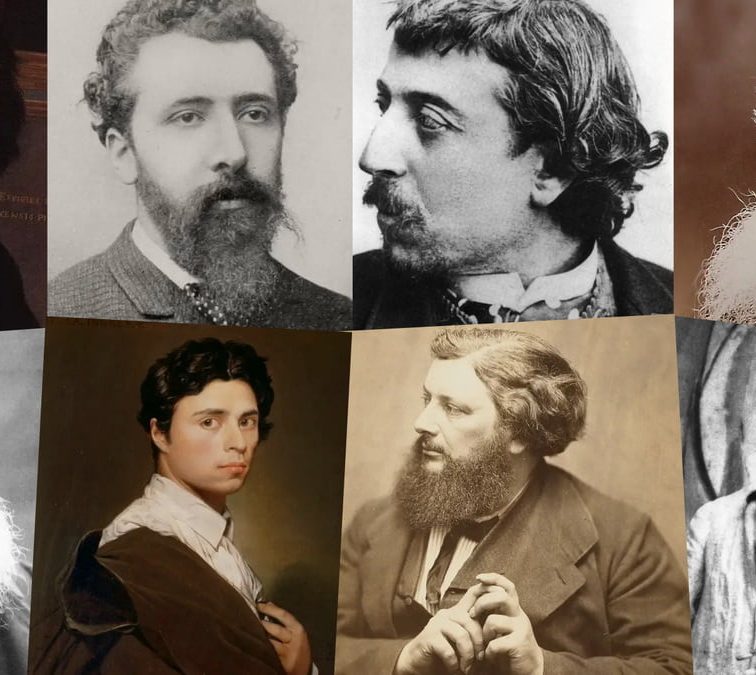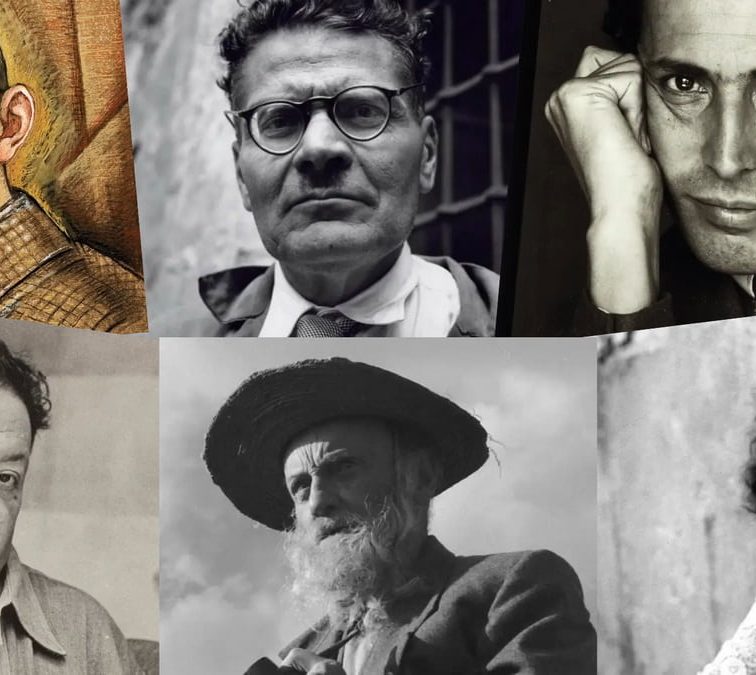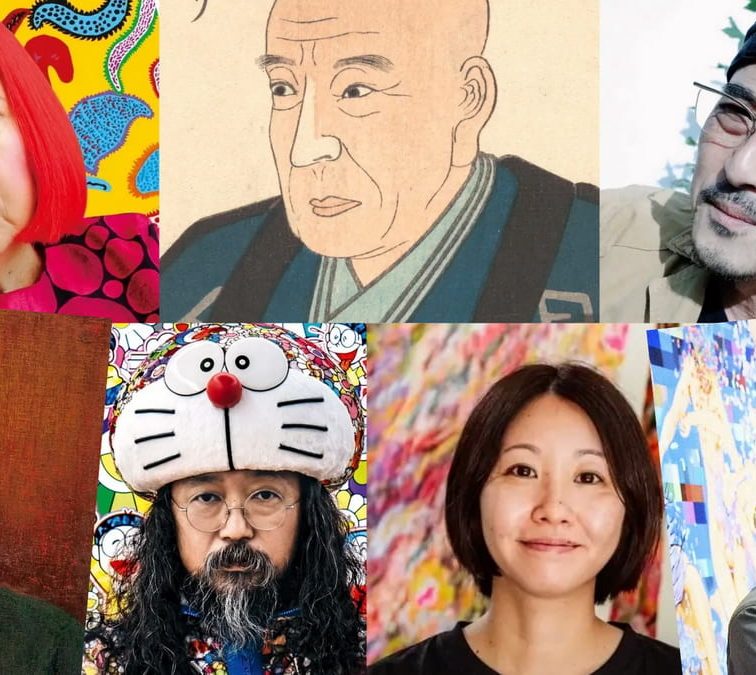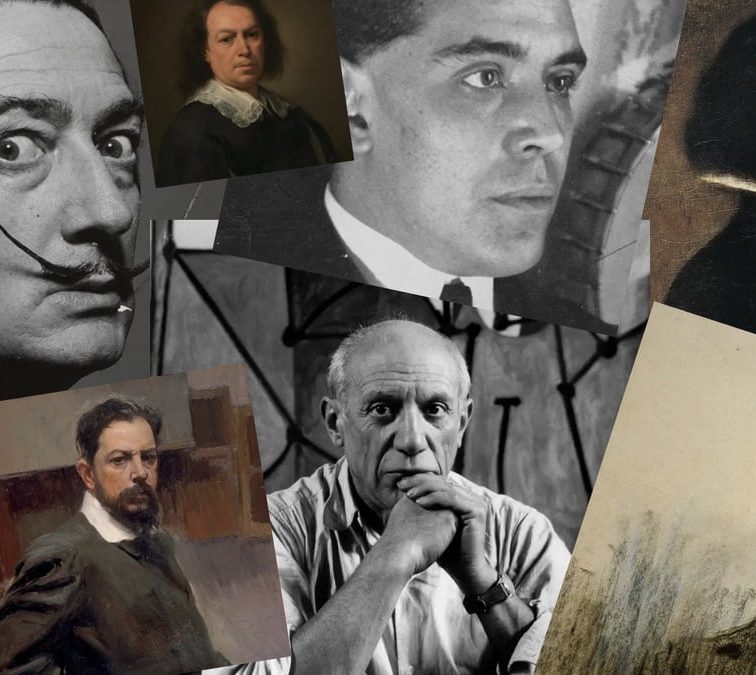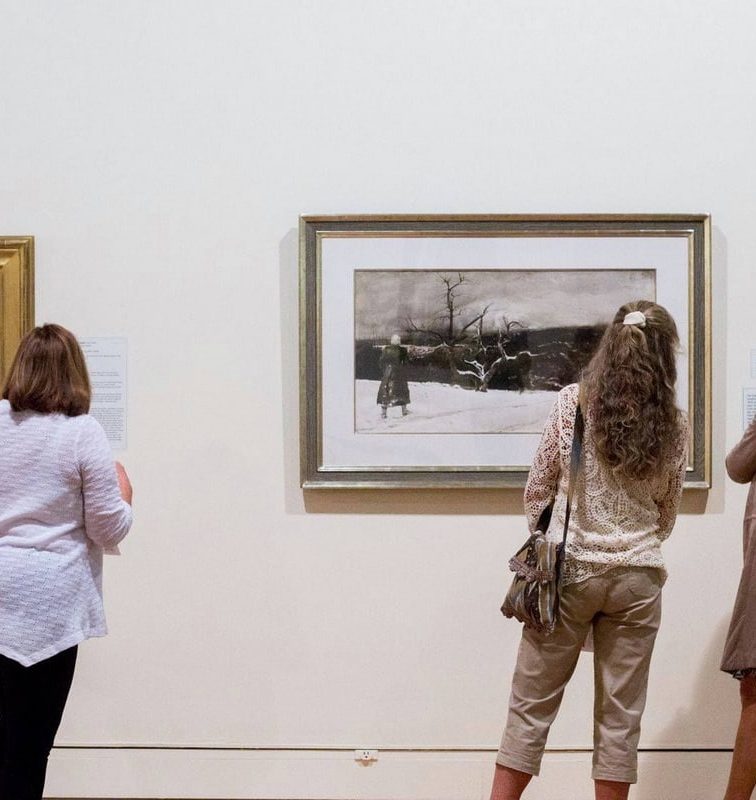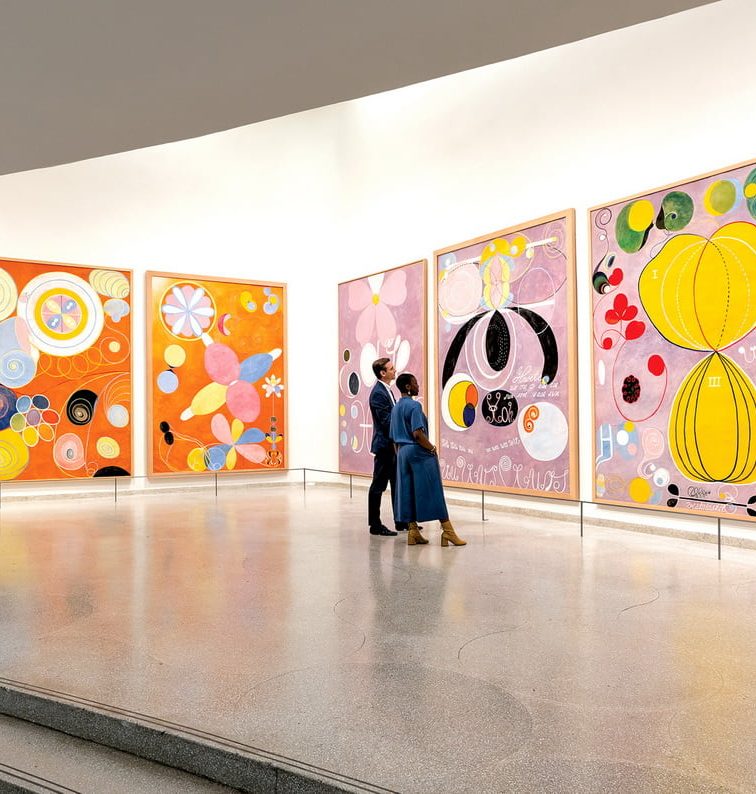Dive into the world of Italian masters, where Leonardo da Vinci’s genius transcends art, envisioning futuristic inventions alongside timeless paintings. Marvel at Michelangelo’s dual prowess in sculpting and painting, redefining Renaissance art.
These visionaries, among others, didn’t just create art; they sparked revolutions in technique and expression. Their impact resonates beyond galleries, influencing culture and history. Join us in celebrating the most famous Italian artists, whose legacies continue to captivate and inspire.
1. Leonardo da Vinci: A Mind Ahead of His Time
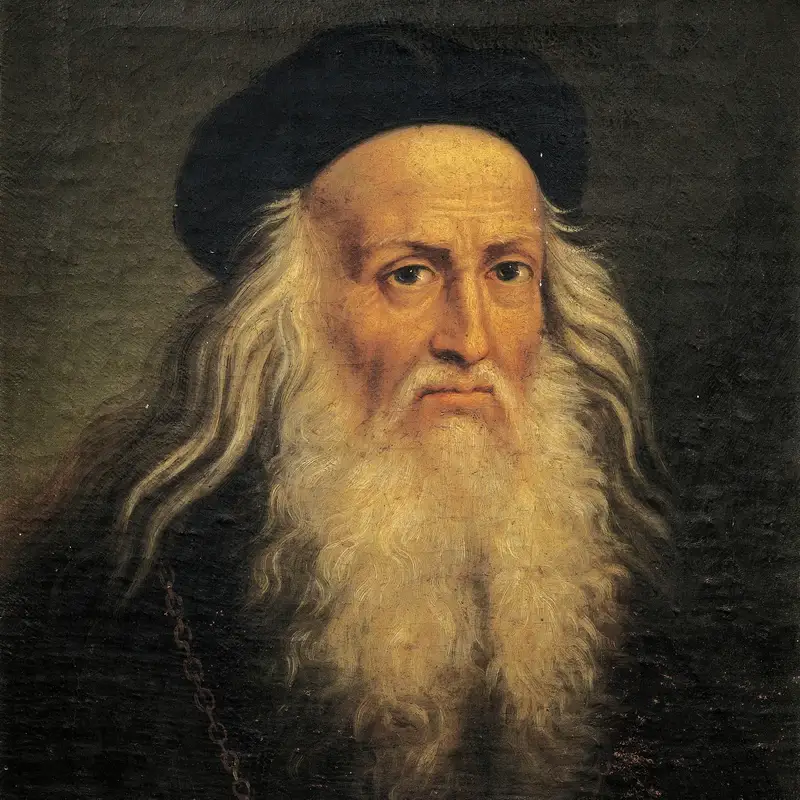
Leonardo da Vinci, born in 1452 in Anchiano, near Vinci, experienced a non-traditional upbringing. His parents, not married to each other, separated early in his life, leading Leonardo to live with his father, Ser Piero, a notary, and his uncle, who nurtured his interest in nature. Despite a lack of formal education beyond basic reading, writing, and math, Leonardo’s artistic talent was evident. Around age 15, he apprenticed with Andrea del Verrocchio in Florence, honing his skills in painting, sculpting, and mechanics.
Milanese Period and Artistic Mastery
In 1482, Leonardo relocated to Milan, working for the Sforza family. This period marked significant artistic development, notably the creation of “The Last Supper,” a masterpiece of composition and emotional expression. Leonardo’s Milanese years also saw him engage in diverse projects, from engineering to sculpture, reflecting his polymath nature. However, the invasion of Milan by the French in 1499 forced Leonardo to leave, leading him to paint several notable portraits, including the enigmatic “Mona Lisa.”
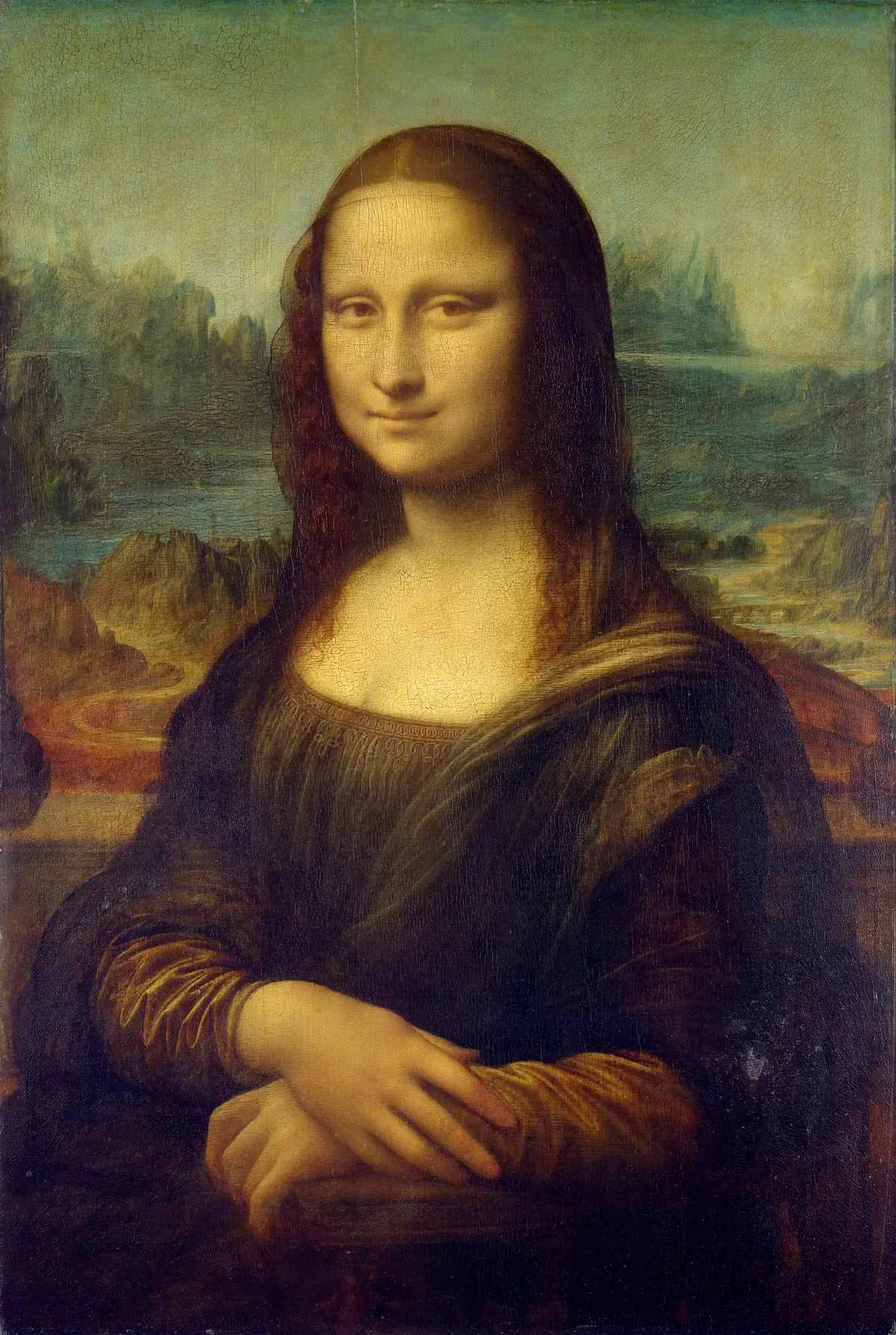
Leonardo da Vinci, “Mona Lisa”, 1503. Image: Wikimedia Commons
Scientific Explorations and Later Years
Leonardo’s interests extended beyond art to encompass anatomy, mechanics, and nature. His notebooks, filled with detailed sketches and ideas, showcased his forward-thinking mind, envisioning inventions like helicopters and tanks centuries before their realization. In 1516, Leonardo moved to France under the patronage of Francis I, where he continued his artistic and scientific pursuits until his death in 1519.
Leonardo da Vinci remains a symbol of Renaissance genius, his work epitomizing the blend of art and science. His legacy, reflected in a relatively small number of surviving paintings, is defined by deep emotional insight, scientific precision, and artistic perfection.
2. Michelangelo Buonarroti: Sculptor, Painter, Architect, Poet
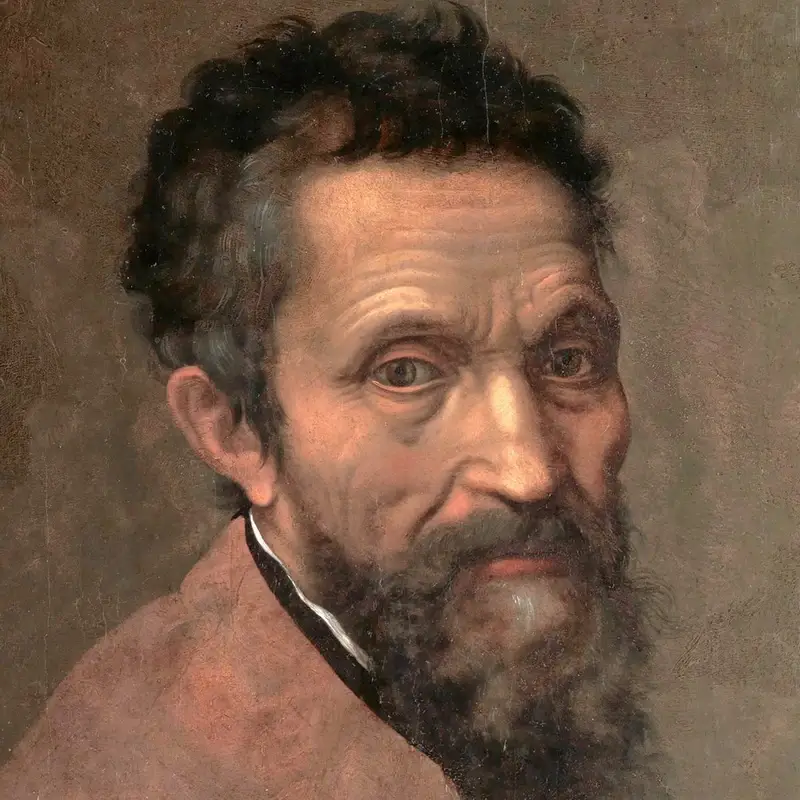
Michelangelo di Lodovico Buonarroti Simoni, born on March 6, 1475, in Caprese, Italy, was a polymath of the Italian Renaissance whose works in sculpture, painting, architecture, and poetry distinguished him as one of history’s most brilliant artists.
Early Life and Artistic Beginnings
The Buonarroti family, with roots in banking, had Michelangelo raised in Florence. His early years in Settignano, where his father owned a marble quarry, nurtured his love for sculpture. By age 13, Michelangelo began his formal art training under Domenico Ghirlandaio, quickly exhibiting a remarkable talent that led him to an apprenticeship in the influential Medici family’s circle.
Sculptural Masterpieces and Artistic Innovations
Michelangelo’s sculptures, like the iconic “David” and the deeply moving “Pietà,” showcase his unparalleled ability to bring marble to life. His mastery over the depiction of human anatomy and expression is evident in these works, revolutionizing Renaissance art and sculpture.
A Painter Against His Will
Though Michelangelo considered himself a sculptor primarily, his painting achievements are no less significant. The frescoes on the Sistine Chapel’s ceiling, a monumental task completed between 1508 and 1512, and “The Last Judgment” on its altar wall, stand as testaments to his prowess in this medium. These works reveal his deep understanding of the human form, imbued with emotional depth and energy.
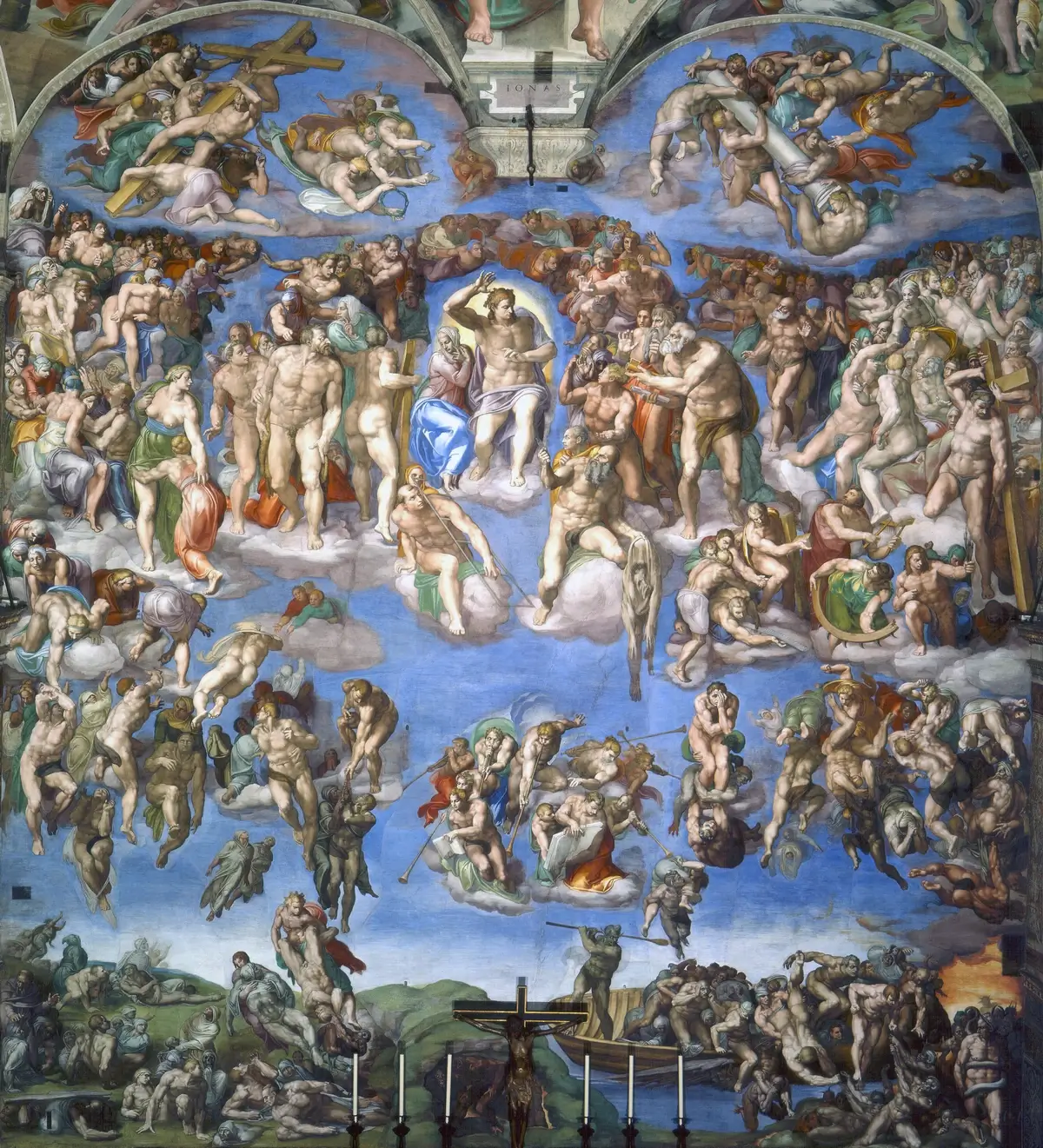
Michelangelo Buonarroti, “The Last Judgment”, from 1536 until 1541. Image: Wikimedia Commons
Architectural Contributions and Poetic Works
Michelangelo’s contributions to architecture were equally influential, with his work on St. Peter’s Basilica in Rome standing out. His designs reflected innovative approaches and a deep understanding of space and structure. Additionally, his poetry offers insight into his artistic and personal life, revealing a thoughtful and complex character.
Michelangelo, who passed away on February 18, 1564, in Rome, remains an iconic figure in art history. His multidisciplinary talents and profound impact on various art forms affirm his status as a true Renaissance man, whose legacy continues to inspire and awe.
3. Raphael Sanzio: The Graceful Master of the High Renaissance
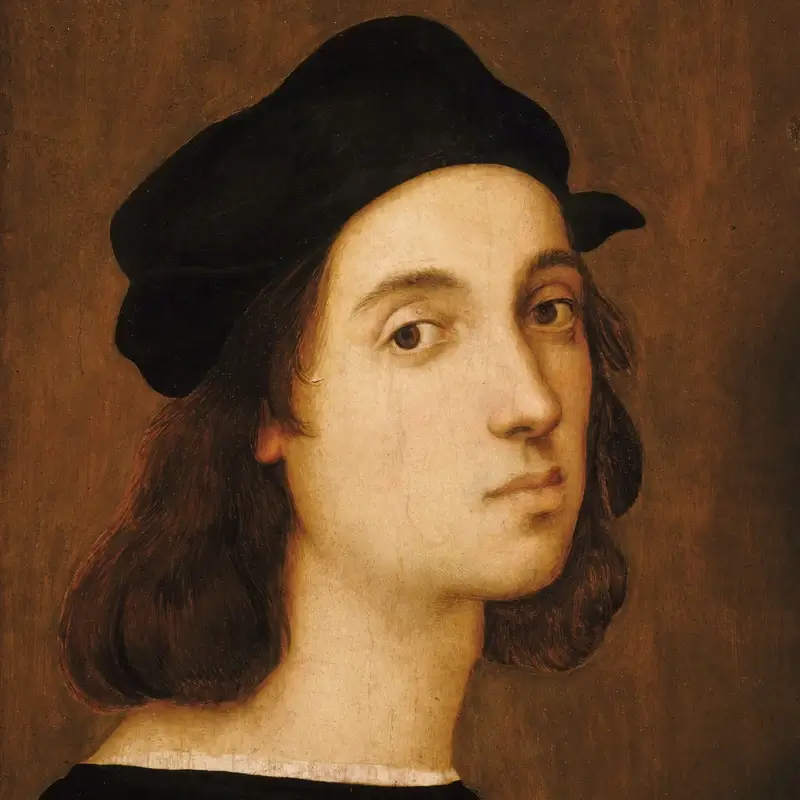
Raphael Sanzio, born on either March 28 or April 6, 1483, in Urbino, Italy, stands tall among the trinity of great masters of the High Renaissance. His works are celebrated for their clarity of form, effortless composition, and the embodiment of the Neoplatonic ideal of human grandeur.
A Prodigious Talent from Urbino
Raphael’s artistic journey began under the tutelage of his father, Giovanni Santi, a court painter in Urbino. His father’s premature death left Raphael, then only eleven, to manage the family workshop, a testament to his early maturity and talent. His formative years were also influenced by the artistic traditions of Florence, which he absorbed during a four-year period from 1504 to 1508.
Rome: The Pinnacle of Raphael’s Career
Invited to Rome by Pope Julius II in 1508, Raphael’s talent flourished in the Vatican. His most celebrated work, “The School of Athens,” located in the Vatican’s Stanza della Segnatura, epitomizes the Renaissance spirit, merging philosophical concepts with artistic perfection. Raphael’s time in Rome was marked by prolific output, overseeing a large workshop and leaving behind a substantial body of work despite his early death at 37.
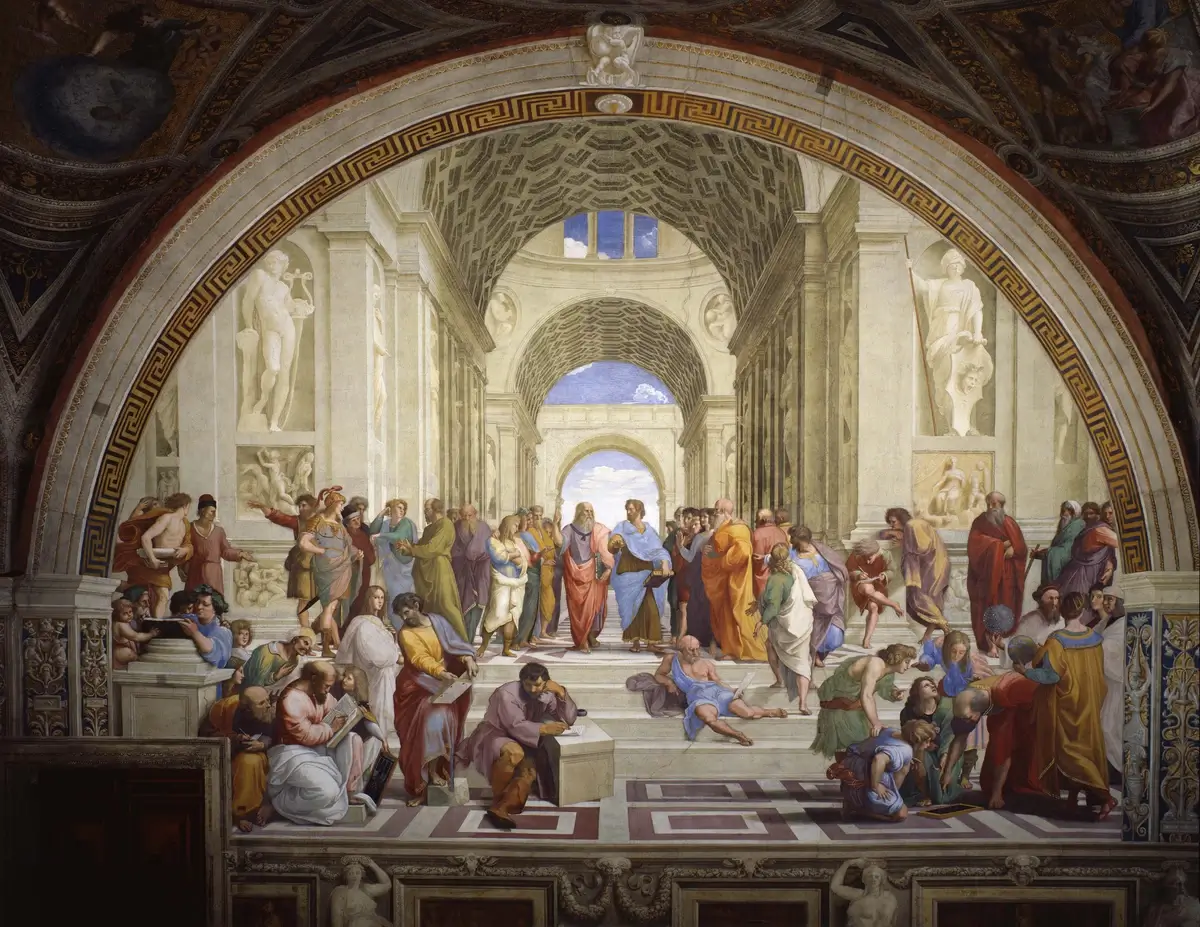
Raphael Sanzio, “The School of Athens”, 1511. Image: Wikimedia Commons
Legacy: The Quintessence of Renaissance Art
Raphael’s influence extended far beyond his lifetime, shaping Neoclassical painting and leaving an indelible mark on Western art. His works, particularly his Madonnas and large figure compositions, are revered for their visual portrayal of human dignity and grace, making him an enduring symbol of Renaissance artistry.
4. Caravaggio: Revolutionizing Painting with Chiaroscuro
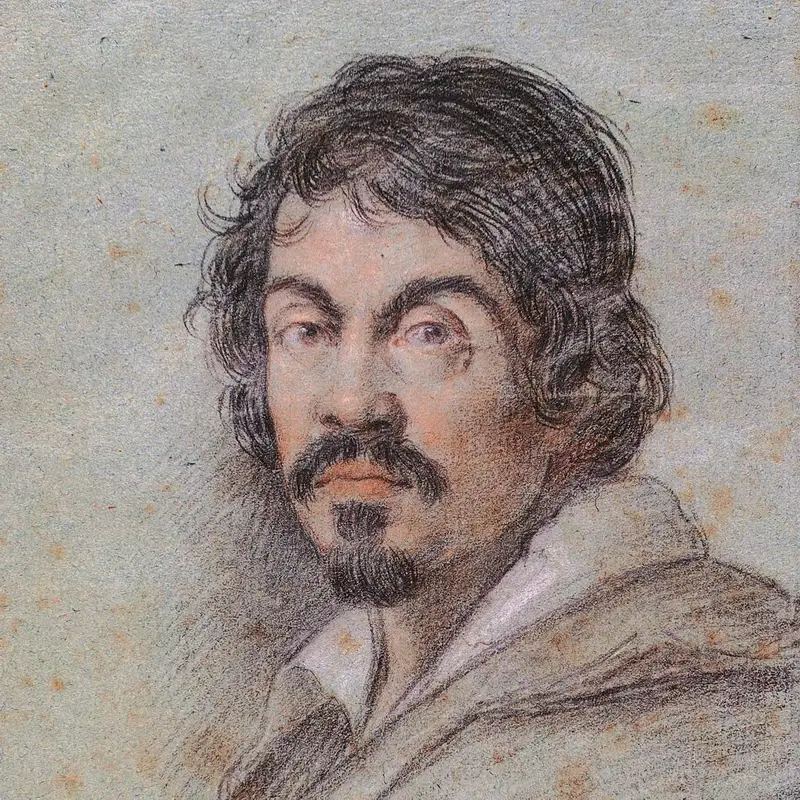
Michelangelo Merisi da Caravaggio, born on September 29, 1571, in Milan, was a pivotal figure in the transition to Baroque painting. His revolutionary use of chiaroscuro and tenebrism redefined artistic standards of the time, creating a dramatic and intense style that profoundly influenced Baroque painting.
Master of Light and Shadow
Caravaggio’s technique emphasized the use of stark light and dark contrasts, known as chiaroscuro, evolving into tenebrism – a style where dramatic lighting is used to highlight subjects against much darker backgrounds. This approach not only added a theatrical quality to his paintings but also heightened the emotional intensity and realism. Caravaggio’s works, characterized by their unsettling realism and visceral depictions of biblical and mythological scenes, often featured common people as models and depicted them in contemporary settings.
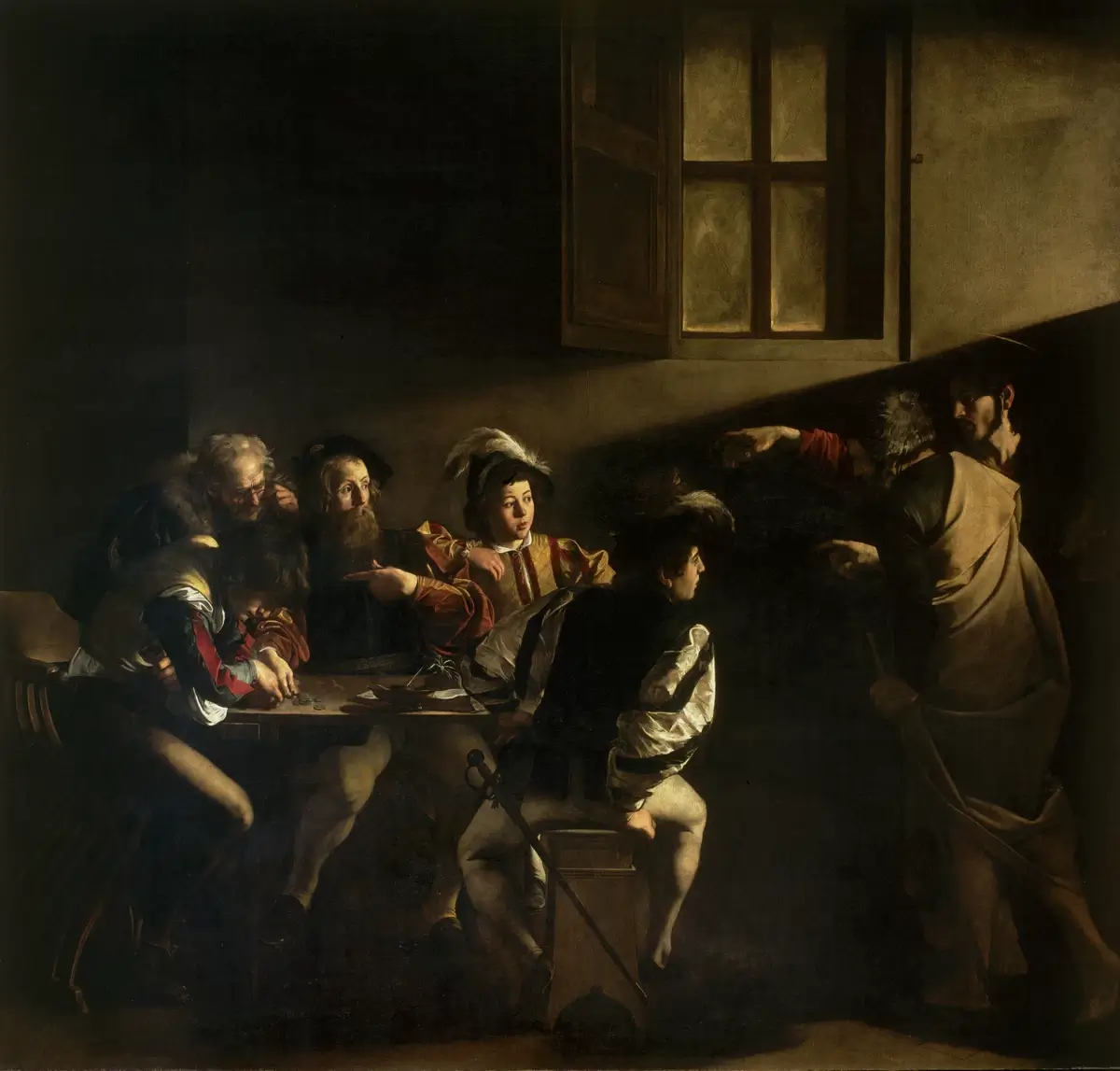
Caravaggio, “The Calling of St. Matthew”, 1600. Image: Wikimedia Commons
Turbulent Life and Artistic Legacy
Caravaggio’s personal life was as dramatic as his paintings. Known for his volatile temperament, his life was marked by violent incidents, culminating in the murder of Ranuccio Tomassoni in 1606, which led to his exile. His later works, created during his time in Naples, Malta, and Sicily, showed a transition in his style with quicker brushstrokes and a more extensive use of reddish-brown tones. Despite dying at the age of 38 in 1610 under mysterious circumstances, Caravaggio left an indelible mark on the art world.
His influence extended beyond Italy, impacting artists like Peter Paul Rubens, Jusepe de Ribera, Gian Lorenzo Bernini, and Rembrandt. The “Caravaggisti,” artists who emulated his style, propagated his dramatic chiaroscuro across Europe, cementing his legacy as a precursor to the Baroque movement and a modern painting pioneer.
5. Titian (Tiziano Vecelli): The Venetian Leader of 16th-Century Art

Titian, born Tiziano Vecelli around 1488/90 in Pieve di Cadore, Republic of Venice, was a central figure in 16th-century Venetian art. His impact on Renaissance painting was profound, with his work extending across religious compositions, portraits, mythologies, and even pastoral landscapes.
Early Beginnings and Artistic Development
Titian’s journey into art began in Venice, where he apprenticed with Giovanni Bellini, one of the most eminent Venetian painters. His early works reflected a blend of Bellini’s style and the tonal subtleties of his contemporary, Giorgione. Titian’s collaboration with Giorgione was so close that it initially made it challenging to distinguish between their works. This period saw Titian develop a mastery of color and landscape, traits that would become hallmarks of his style.
Evolving Style and Venetian Dominance
Throughout his career, Titian’s style evolved significantly. He became renowned for his use of color and innovative painterly techniques, which continued to influence Western art well into the 17th century. One of his first major commissions, the Assumption of the Virgin for Santa Maria Gloriosa dei Frari in Venice, showcased a departure from conventional approaches, featuring more dynamic figures and a vivid use of color. This work, among others, cemented his reputation as Venice’s leading artist.
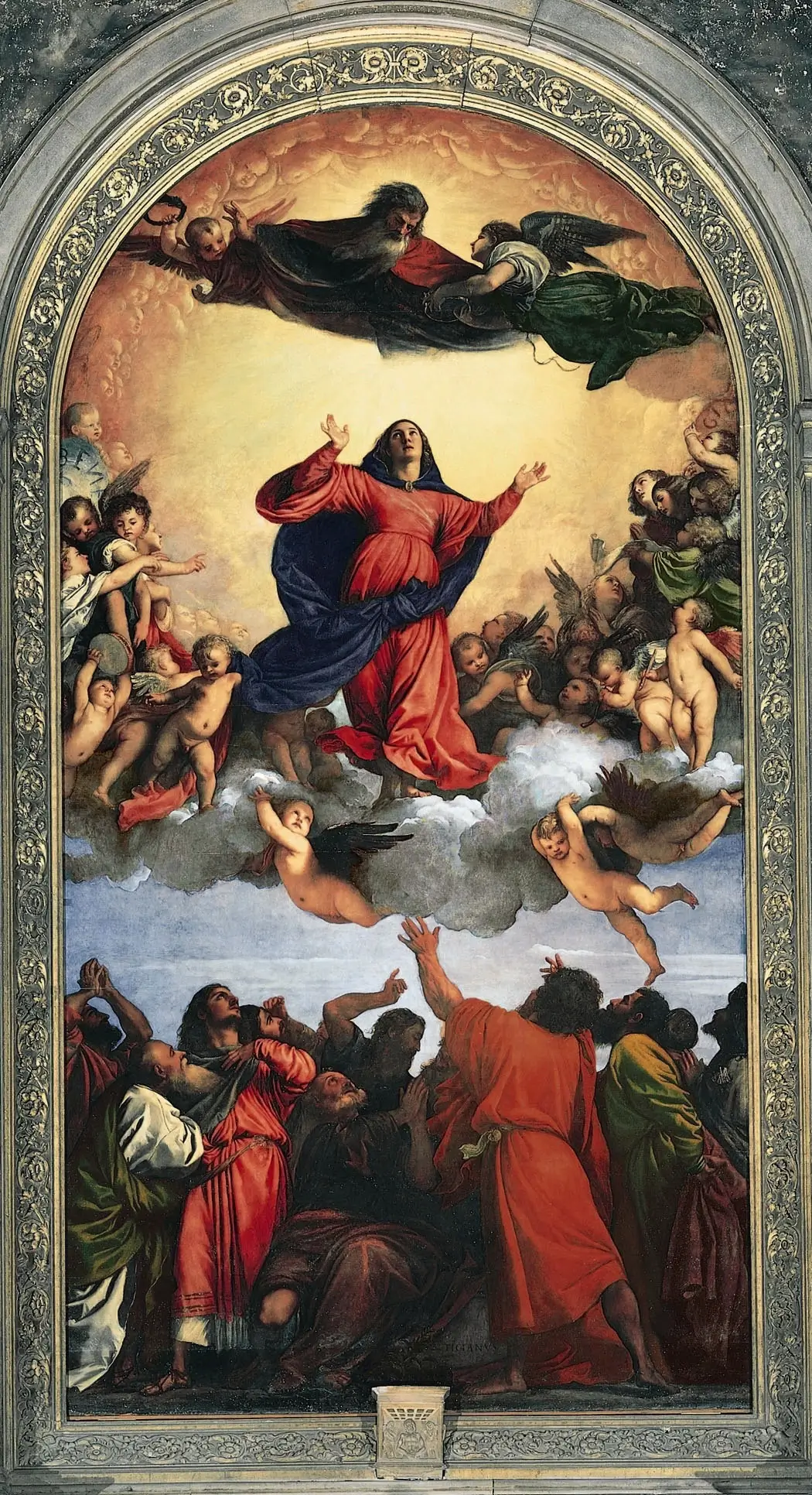
Titian, “Assumption of the Virgin”, 1518. Image: Wikimedia Commons
Portraiture and Mythological Works
Titian achieved international fame through his portraits, capturing not just the physical likeness but also a psychological depth in his subjects, including prominent figures like Emperor Charles V and Pope Paul III. His mythological subjects, termed as ‘poesie’, were akin to visual poetry. Works like “Bacchus and Ariadne” and the “Venus of Urbino” are notable for their sensual beauty and nuanced representation of mythological themes.
Legacy and Influence
Titian’s influence on the art world was immense and long-lasting. His painterly approach and use of color set new standards in art, influencing subsequent generations of artists. Recognized by contemporaries as “The Sun Amidst Small Stars,” his legacy endures as a testament to his unrivaled skill in the Venetian school and Renaissance art.
6. Sandro Botticelli: The Florentine Master of Mythological Scenes
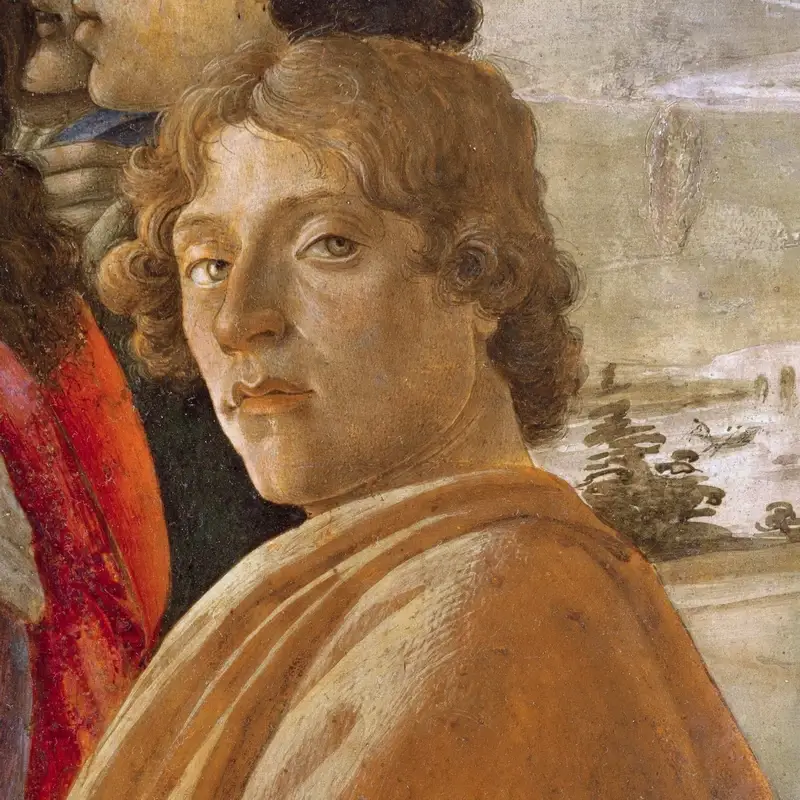
Sandro Botticelli, born Alessandro di Mariano Filipepi around 1445 in Florence, was a central figure in the Florentine Renaissance. Known for his exquisite mythological scenes and religious subjects, Botticelli’s works like “The Birth of Venus” and “Primavera” epitomize the spirit of the Renaissance for modern audiences.
Early Influences and Artistic Style
Botticelli’s journey into art began under the mentorship of Filippo Lippi, whose influence is evident in Botticelli’s graceful lines and delicate portrayals, particularly in early works like the “Madonna of the Eucharist”. This period saw the development of Botticelli’s distinctive style, marked by elegant figures, a linear sense of form, and a unique approach to coloring.
Mythological Masterpieces and Portraits
Botticelli’s mythological paintings, notably “The Birth of Venus” and “Primavera”, showcase his ability to combine classical themes with the aesthetic ideals of the Renaissance. These paintings are renowned for their beauty and complexity, blending mythological subjects with a new level of emotional depth and narrative. In addition to these mythological scenes, Botticelli’s portraits are celebrated for their expressive depth and subtle portrayal of character.
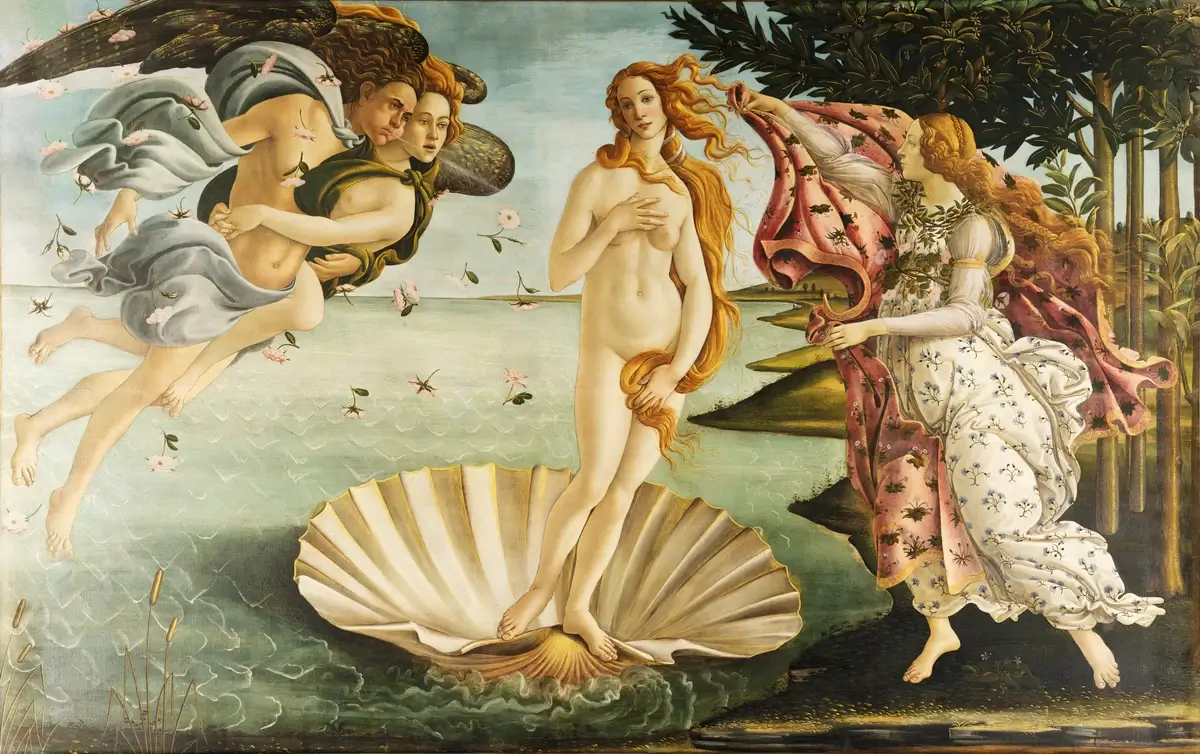
Sandro Botticelli, “The Birth of Venus”, 1485. Image: Wikimedia Commons
Later Life and Legacy
Despite his success, Botticelli’s life was not without challenges. In his later years, his style became more personal and somewhat mannered, moving away from the trends set by contemporaries like Leonardo da Vinci. Botticelli passed away in 1510 in Florence, leaving behind a legacy that profoundly influenced the course of Western art.
7. Giotto di Bondone: The Trailblazer of Renaissance Painting

Giotto di Bondone, born around 1267 near Florence, Italy, is celebrated as the most important Italian painter of the 14th century and a pivotal figure in the transition to the Renaissance style. Giotto’s frescoes and panel paintings marked a significant departure from the prevalent Byzantine style, introducing a more naturalistic approach that would lay the foundations for modern painting.
Artistic Journey and Innovations
Giotto’s early training under the Florentine painter Cimabue was instrumental in his development. He absorbed Cimabue’s attempts to break away from medieval art conventions, but Giotto succeeded where Cimabue had not fully realized his ambitions. Giotto’s genius lay in his ability to bring a lifelike and emotional depth to his subjects, making them the sole focus of his work.
Masterpieces and Major Contributions
Giotto’s most renowned works include the Scrovegni Chapel frescoes in Padua, completed around 1305, and his design for the campanile (bell tower) of the Florence Cathedral in 1334. The frescoes in the Scrovegni Chapel, depicting the Life of the Virgin and the Life of Christ, are considered masterpieces of the Early Renaissance. The style and techniques he employed in these works, especially in the depiction of human figures and emotional expressions, were groundbreaking.
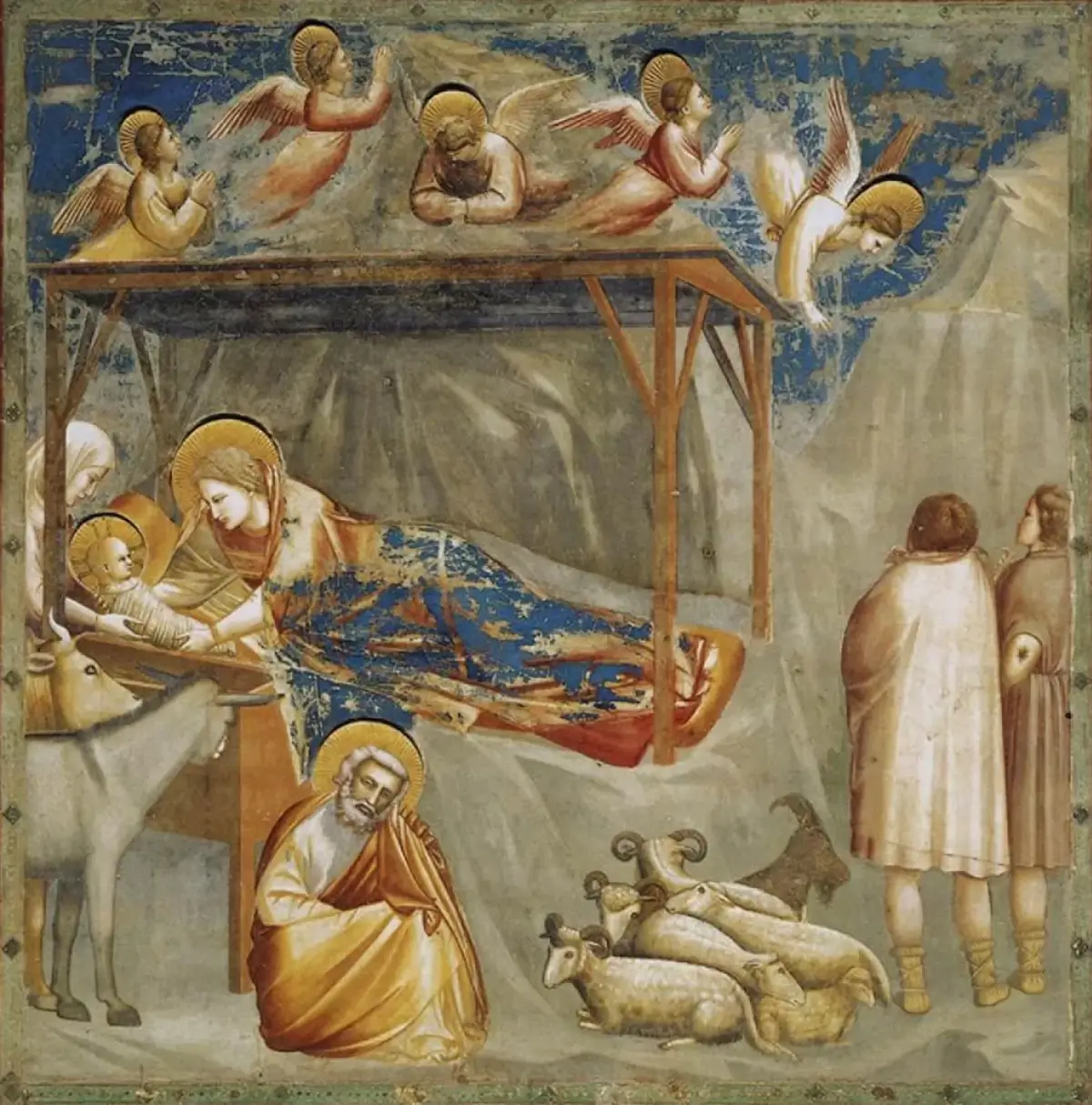
Giotto’s fresco “The Nativity,” created around 1305-1306 in the Arena Chapel in Padua, Italy, is a depiction of Jesus’ birth. Image: Britannica
The Assisi Controversy and Legacy
The attribution of the frescoes in the Upper Basilica of Saint Francis in Assisi remains one of the most debated topics in art history. While Giotto’s involvement is uncertain, the frescoes’ style significantly influenced later Renaissance art. Despite this controversy, Giotto’s impact on the art world is indisputable. He is revered for his innovative approach to painting, which emphasized drawing accurately from life and marked a clear departure from the Byzantine style that had dominated for centuries.
Giotto’s work not only influenced his contemporaries but also shaped the path for future generations of artists, making him a true pioneer of the Renaissance.
8. Giovanni Bellini: Innovator of Venetian Renaissance
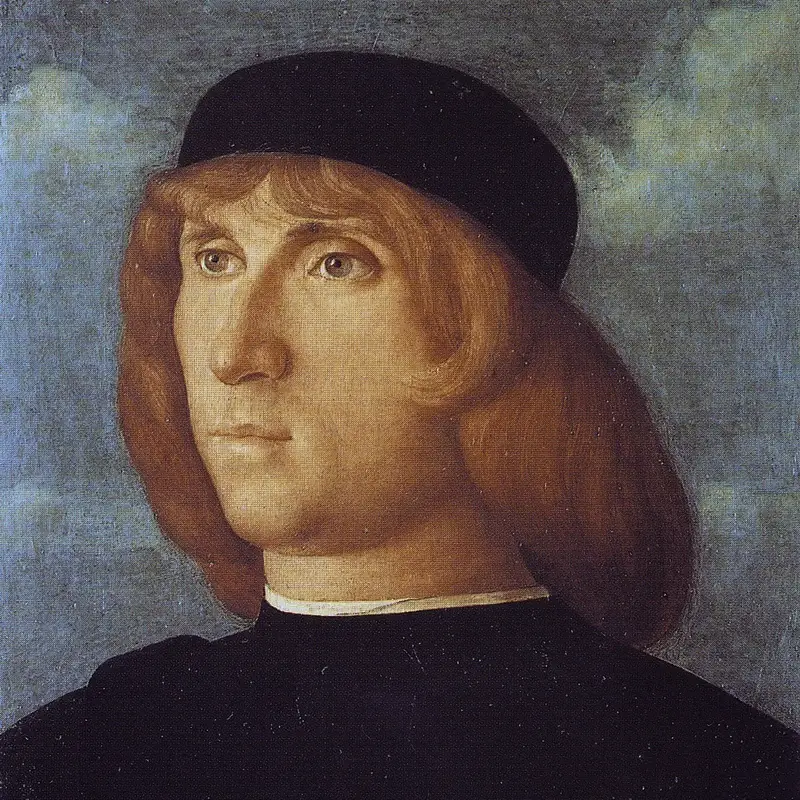
Giovanni Bellini, born around 1430 in Venice, was a seminal figure in the Venetian Renaissance. His work, deeply influenced by the increasing Renaissance spirit in Venice, marked a significant shift in the artistic landscape of the region. Renowned for his religious scenes, Bellini’s work is notable for its integration of detailed landscape settings, enriching the traditional religious narrative.
Artistic Lineage and Early Influences
Bellini hailed from a family of illustrious artists. His father, Jacopo Bellini, was a renowned painter, and his brother, Gentile Bellini, also achieved acclaim in the art world. Giovanni’s early works were shaped by his father’s Gothic style and the strict formality of the Paduan School, visible through Andrea Mantegna’s influence.
Revolutionizing Venetian Painting
Bellini’s artistic journey saw a significant evolution. His early adherence to the Gothic style and the rigidity of the Paduan School gradually gave way to a more mature, defining style. After encountering Antonello di Messina, Bellini transitioned from traditional egg tempera to rich, slow-drying oil paints. This shift allowed for a greater expression of coloration, atmosphere, and natural light in his works. His mastery of oil painting brought a new depth and realism to his depictions of both landscapes and human figures.
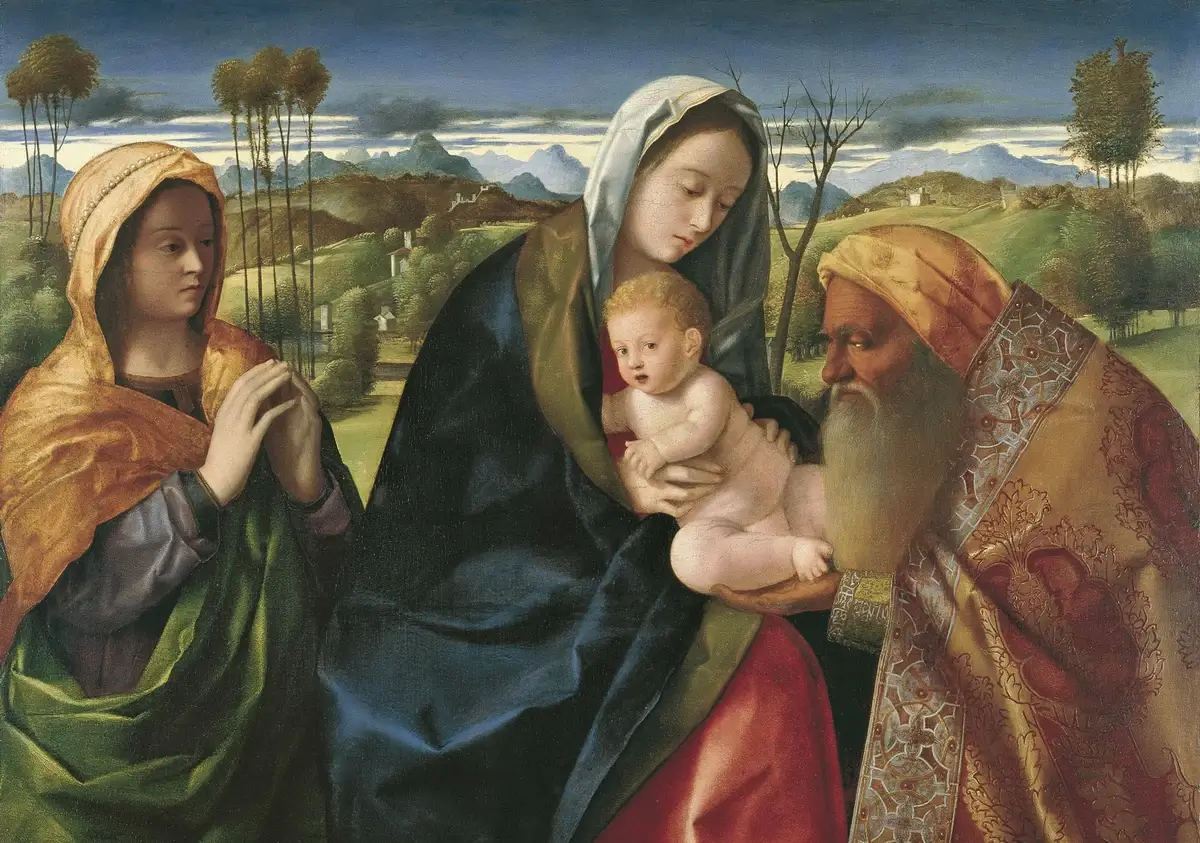
Giovanni Bellini, “The Sacred Conversation”, 1510. Image: Wikimedia Commons
Portraiture and Teaching Legacy
Bellini was not only acclaimed for his religious works but also for his portraits. His understanding of color variation and light was evident in his portrayal of human forms and clothing, capturing the subtleties and depth of his subjects. Among his pupils were Renaissance painters Giorgione and Titian, who would go on to surpass their master in fame and influence.
Enduring Influence and Masterpieces
Bellini’s artistic innovation and mastery of form and perspective marked a significant shift in Venetian painting. His approach to landscape painting, in particular, set the stage for future generations of artists, securing his legacy as a pivotal figure in the Venetian Renaissance. His works, such as “The Feast of the Gods,” “Doge Leonardo Lorodan,” and “The Sacred Conversation,” exemplify his skill in using color to create harmony and his ability to infuse his characters with a sense of life and emotion.
Bellini’s contributions to the Venetian Renaissance are celebrated for their innovative pigmentation and ambiance, influencing religious painting and portraiture alike. His work signified a profound shift towards the Renaissance ideals in Venetian art, blending religious themes with an unprecedented naturalism and depth, forever altering the course of art history in Venice.
9. Giorgione (Giorgio Barbarelli da Castelfranco): The Mysterious Venetian
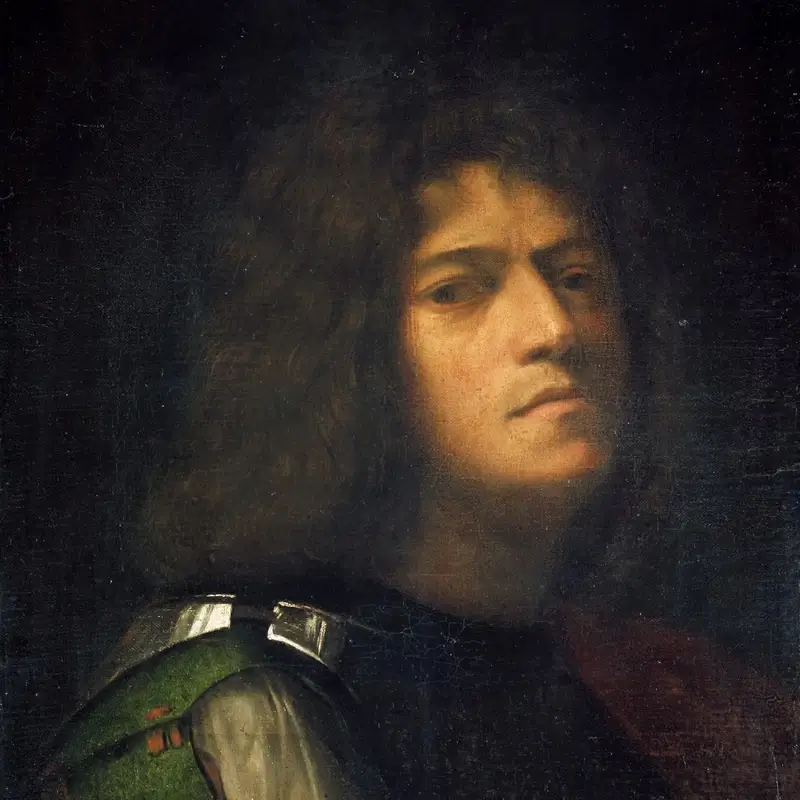
Giorgione, born around 1477/78 in Castelfranco Veneto, Republic of Venice, and passing away before November 7, 1510, in Venice, was an enigmatic and influential figure in the Venetian Renaissance. Despite a relatively brief life, his work profoundly impacted the Venetian school of Italian Renaissance painting, known for its emphasis on color and mood. This school contrasted sharply with the more linear, design-led style of Florentine painting.
Early Life and Artistic Evolution
Little is known about Giorgione’s life, with most information coming from the 16th-century artist and biographer Giorgio Vasari. Giorgione’s artistic journey began under the tutelage of Giovanni Bellini, the foremost Venetian painter of the time. Early in his career, Giorgione painted portraits of notable figures such as the Doge Agostino Barbarigo and the condottiere Consalvo Ferrante. His style, characterized by its use of deeply saturated colors and innovative subjects, was deeply influenced by his Venetian surroundings.
Masterworks and Artistic Legacy
Among Giorgione’s notable works are “The Tempest,” “The Three Philosophers,” and “Sleeping Venus.” “The Tempest” is particularly significant, representing a milestone in Renaissance landscape painting. This work and others like “Sleeping Venus” show Giorgione’s skill in using landscape to create atmosphere, a technique he developed in parallel with his contemporary Leonardo da Vinci. His innovative approach to painting, especially his use of sfumato and attention to light, set new standards in the art world.
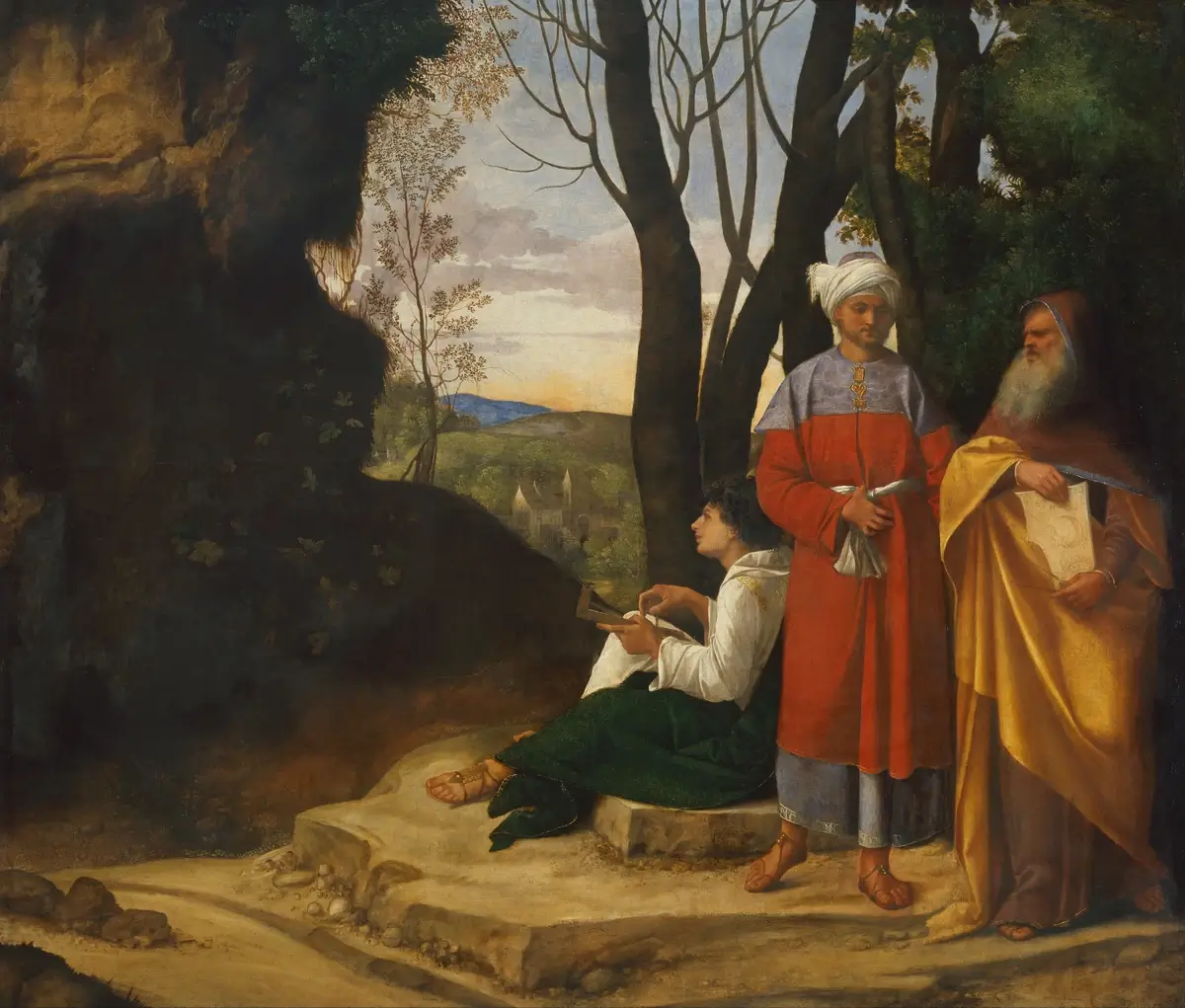
Giorgione, “The Three Philosophers”, 1509. Image: Wikimedia Commons
Relationship with Titian and Influence on Venetian Art
Giorgione’s close association with Titian, another giant of Venetian painting, was a significant element of his career. They both studied under Bellini and worked together on various projects. Giorgione introduced new themes in his paintings, focusing less on narrative and more on embodying moods and feelings, much like a musician might use sounds. This shift towards capturing moods and lyrical feelings became a hallmark of Venetian art and was followed by his contemporaries and successors, including Titian.
Giorgione’s death, attributed to the plague, added to his mystique and the fascination surrounding his life and work. His artistic legacy continues to intrigue and inspire, with his unique approach to painting and subject matter leaving an indelible mark on the history of art.
10. Piero della Francesca: A Pioneer in the Use of Perspective

Piero della Francesca, born circa 1416/17 in Sansepolcro, Republic of Florence, is celebrated as a pioneer in the use of perspective in Early Renaissance painting. His works are distinguished by a serene humanism and a masterful use of geometric forms and perspective.
Formative Years and Artistic Development
Piero’s early years were spent in his hometown of Sansepolcro. Little is known about his initial artistic training, but it’s believed he was influenced by local Sienese artists. His first documented work was in collaboration with Domenico Veneziano in Florence around 1439, a period crucial to his development in the early Renaissance style. In Florence, Piero likely encountered the works of Donatello, Masaccio, and other luminaries, absorbing their emphasis on color and light.
Returning to Sansepolcro in 1442, Piero’s career as an artist began to flourish. His work on the Misericordia Altarpiece, though slow in execution, demonstrates his fondness for geometric form and a careful, disciplined approach.
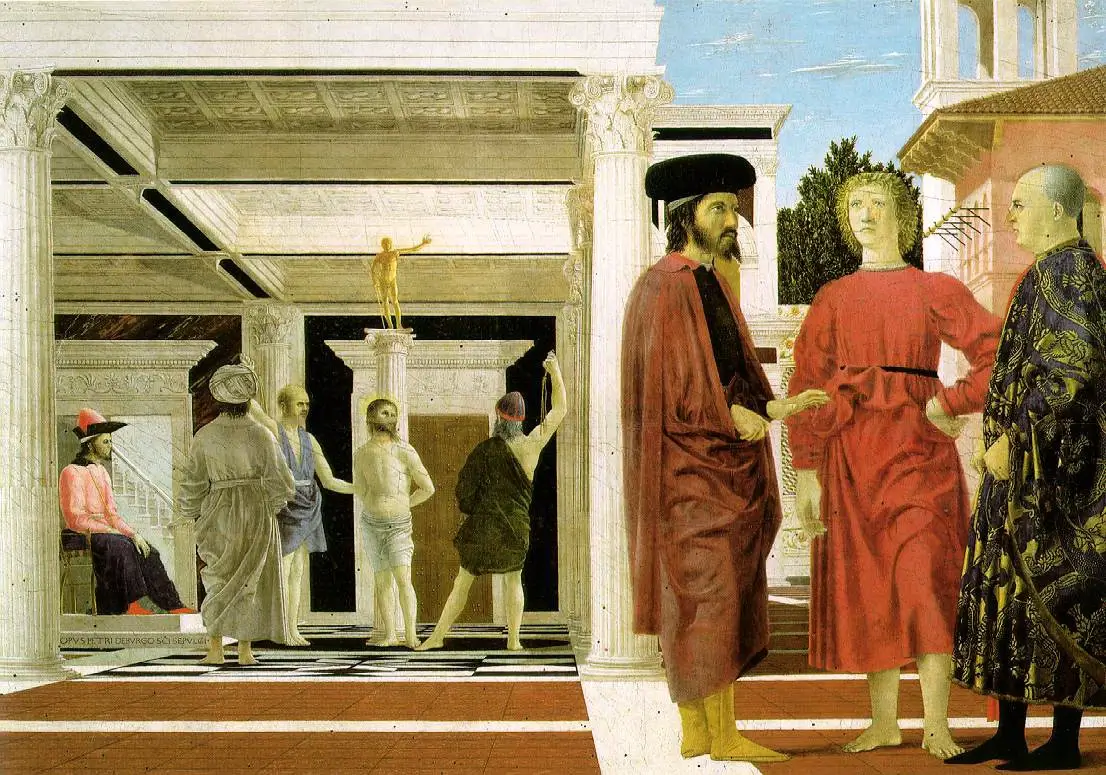
Piero della Francesca, “The Flagellation of Christ”, probably 1468–1470. Image: Wikimedia Commons
Masterworks and Use of Perspective
Piero’s use of perspective and geometry is vividly demonstrated in his frescoes, such as “The History of the True Cross” in the church of San Francesco, Arezzo. This cycle, painted between 1452 and 1466, showcases his ability to unify multiple narratives within a continuous landscape through the skillful use of perspective.
Another of his famous works, “The Flagellation of Christ” (c.1455), exemplifies Piero’s mastery of linear perspective. The painting features a mysterious scene where the foreground and background interactions create an intriguing spatial composition. The detailed rendering of floor tiles and columns in this work is so precise that it has allowed art historians to reconstruct the full space depicted.
“The Resurrection” (c. 1463–65), another notable fresco by Piero, originally in the civic hall of Sansepolcro, displays a masterful use of space and perspective. The painting is significant for its connection to the founding myth of Sansepolcro and its illusionistic portrayal of Christ stepping out of the picture.
Legacy and Influence
Piero della Francesca is recognized for his significant contributions to the Italian Renaissance, blending mathematics and art. His paintings, characterized by their calm and disciplined exploration of perspective, had a profound influence on later artists and are appreciated for their serene humanism and innovative use of geometry in art.
11. Andrea Mantegna: A Forerunner of Renaissance Perspective
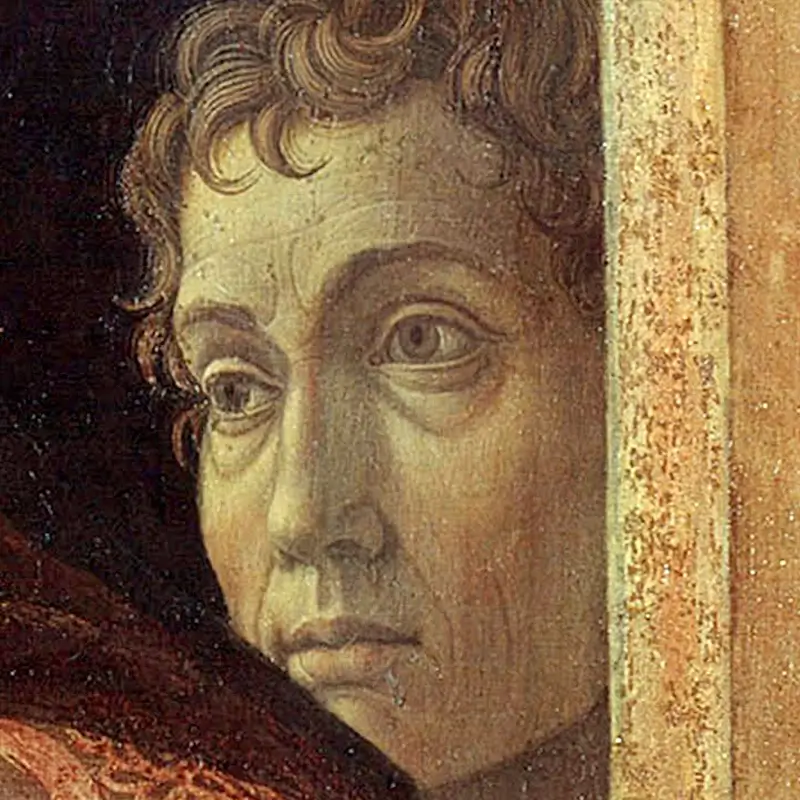
Andrea Mantegna, born in 1431 near Vicenza in the Republic of Venice, stands as a pivotal figure in the Early Renaissance, particularly known for his mastery of perspective and illusionistic art. His works, such as the “Camera degli Sposi” and the “Ovetari Chapel frescoes,” display his innovative approach to spatial representation.
Early Years and Paduan Influence
Mantegna’s talent was apparent from an early age. Adopted by the painter Francesco Squarcione, he was exposed to a rigorous study of ancient Roman art and sculpture. This early influence is evident in his works, which often display a strong sense of architectural form and detail. At 17, Mantegna established his own workshop, indicating both his precocious skill and a desire for artistic independence.
Artistic Style and Techniques
Mantegna’s style is characterized by its use of forced perspective and a sculptural approach to figure drawing, influenced by his study of Roman art and his interaction with other artists in Padua, including Donatello. His works often feature tightly folded draperies and muscular, bony figures, demonstrating a preference for a certain rigidity and austerity over more fluid forms of expression.
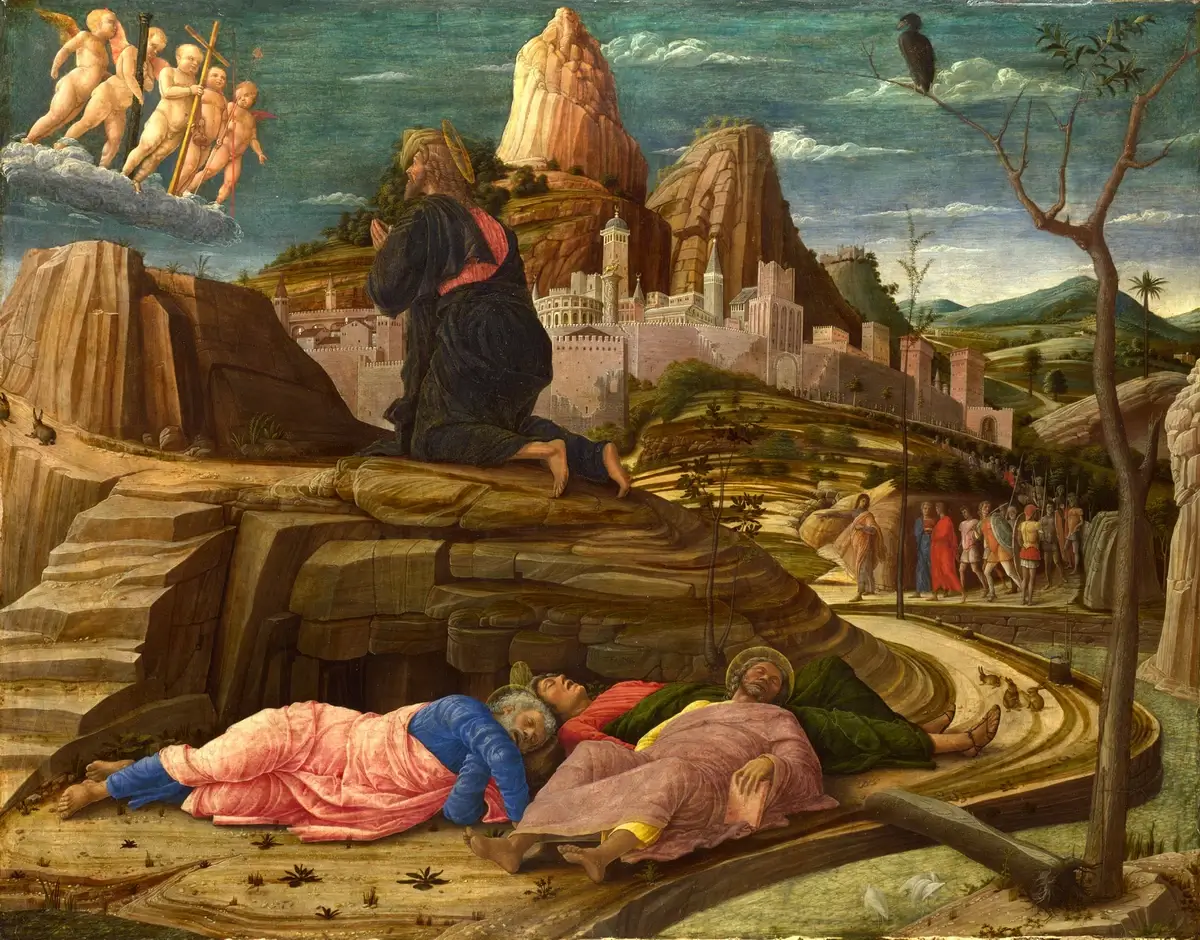
Andrea Mantegna, “The Agony in the Garden”, between 1458 and 1460. Image: Wikimedia Commons
The Camera degli Sposi and Perspective Experiments
One of Mantegna’s most famous works, the “Camera degli Sposi” in the Palazzo Ducale of Mantua, showcases his skill in creating a cohesive illusionistic environment. This work is renowned for its use of di sotto in su (from below to above) perspective, creating a dramatic sense of space and depth. The figures in this fresco look down into the room, playfully engaging with the viewer’s space, a technique that was groundbreaking at the time and influenced many later artists.
Influence and Legacy
Mantegna’s work had a lasting impact on the development of Renaissance art. His experiments with perspective and spatial illusion were particularly influential, advancing the technical and aesthetic boundaries of painting during his time. His ability to blend classical themes with Renaissance humanism marks him as a key figure bridging the medieval and Renaissance periods in art.
12. Tintoretto (Jacopo Comin): The Fierce Venetian Painter
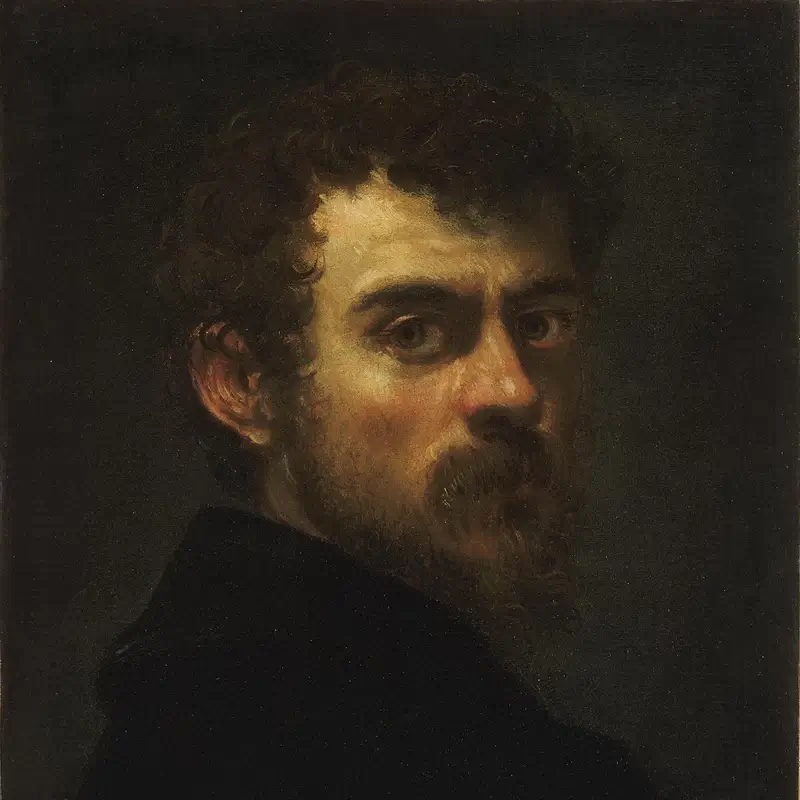
Tintoretto, born Jacopo Robusti in Venice around 1518, was an exceptional Mannerist painter of the Venetian school, known for his dramatic use of perspective and light. His work, characterized by robust, muscular figures and dynamic compositions, showcased an innovative approach to painting that combined the formal elements of the Tuscan school with the coloristic traditions of Venice.
Early Development and Artistic Education
Tintoretto’s artistic journey began in Venice, where little is known about his formal training. His biographers suggest a brief apprenticeship with Titian, which ended abruptly due to a clash of personalities or Titian’s jealousy of his student’s talent. Tintoretto’s style was deeply influenced by Michelangelo’s work, and although it’s uncertain if he saw Michelangelo’s masterpieces in person, his studies based on sculptural maquettes or works influenced by Michelangelo are evident in his paintings.
Career and Notable Works
Tintoretto’s career flourished with his innovative use of perspective and narrative clarity. His early works, including the “Miracle of the Slave” (1548), brought him wide attention and acclaim. This painting, with its theatricality and unusual color choices, marked a turning point in his career, leading to numerous commissions. Tintoretto was known for his speed in painting, which was both admired and criticized by his contemporaries. His works often featured intense drama, as seen in “The Crucifixion” (1565), a large-scale painting showcasing a complex composition with a dramatic panorama.
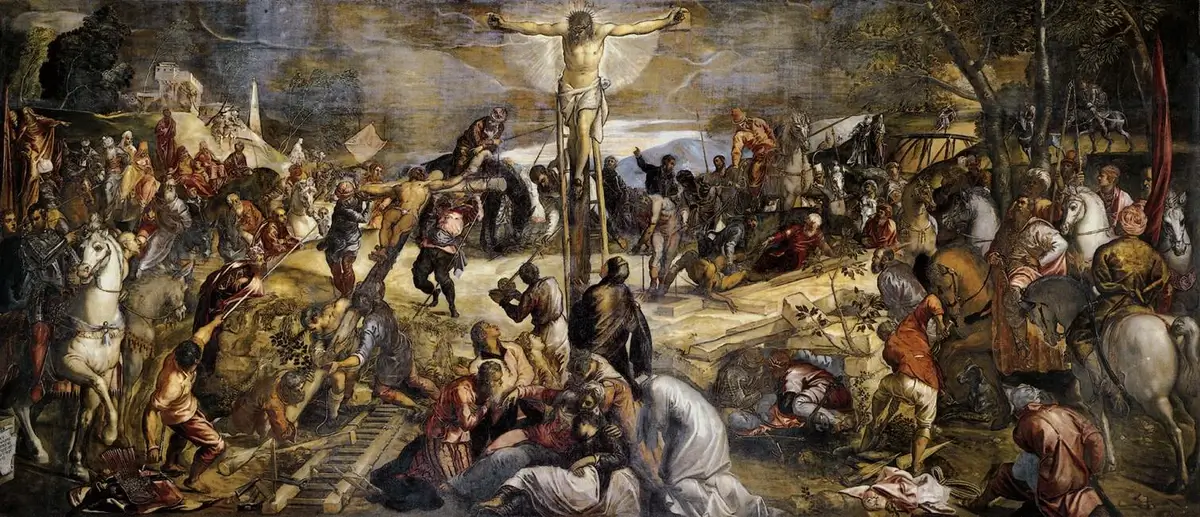
Tintoretto, “The Crucifixion”, 1565. Image: Wikimedia Commons
Influence and Legacy
Tintoretto’s influence extended beyond his lifetime, with his dramatic and expressive style contributing significantly to the development of Baroque art. His unique approach to composition, combining vigorous execution and a visionary spirit, marked him as a key figure in the transition from Renaissance to Baroque art styles. Tintoretto’s legacy in Venetian painting, particularly his bold use of perspective and light, remains a testament to his status as one of the great masters of the late Renaissance.
13. Paolo Veronese: The Master of Color and Narrative
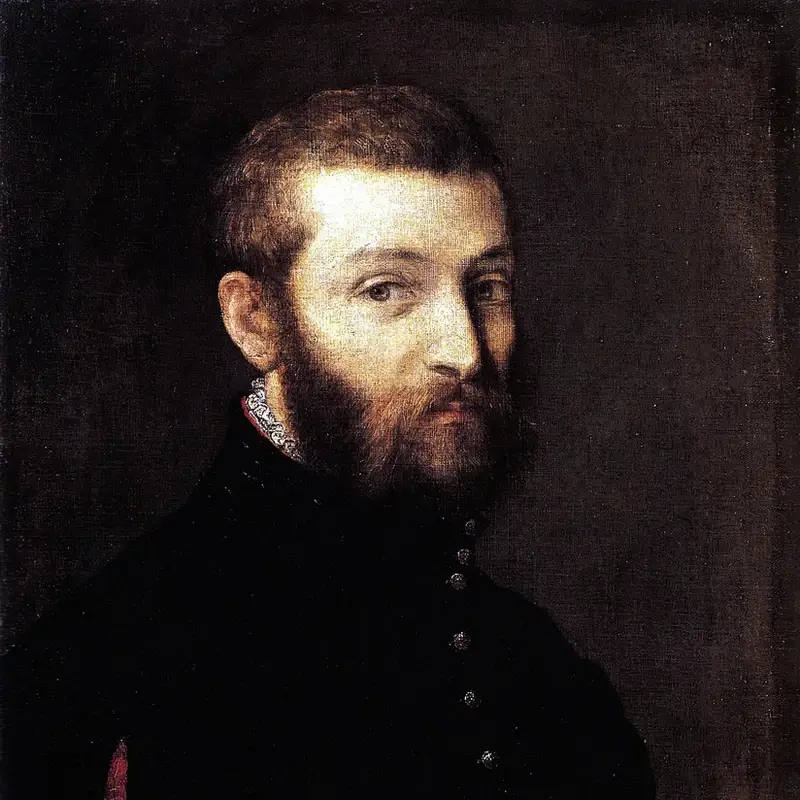
Paolo Veronese, born in 1528 in Verona, was a luminary of the Venetian school, renowned for his large, opulent canvases depicting allegorical, biblical, and historical subjects. His works, famous for their splendid color and classicizing Renaissance architecture, exemplify his mastery of both color and composition.
Artistic Beginnings and Influences
Veronese, originally named Paolo Caliari, displayed an early interest in painting, leading to an apprenticeship with Antonio Badile. His initial works showed the influence of Badile, coupled with a fascination for Mannerist art and the works of great masters like Giulio Romano, Raphael, Parmigianino, and Michelangelo. This blend of influences paved the way for his unique artistic language, combining luminous architectural frameworks with animated foregrounds and backgrounds.
Signature Works and Venetian Triumphs
Veronese’s career in Venice began with a bang, as he received commissions for the Palazzo Ducale and the church of S. Sebastiano. His paintings, such as “The Wedding at Cana” and “The Feast in the House of Levi,” are celebrated for their grandeur and complex narrative structures. These works often feature a multitude of figures, set against vast and splendid architectural backdrops, blending biblical subjects with contemporary Venetian life.
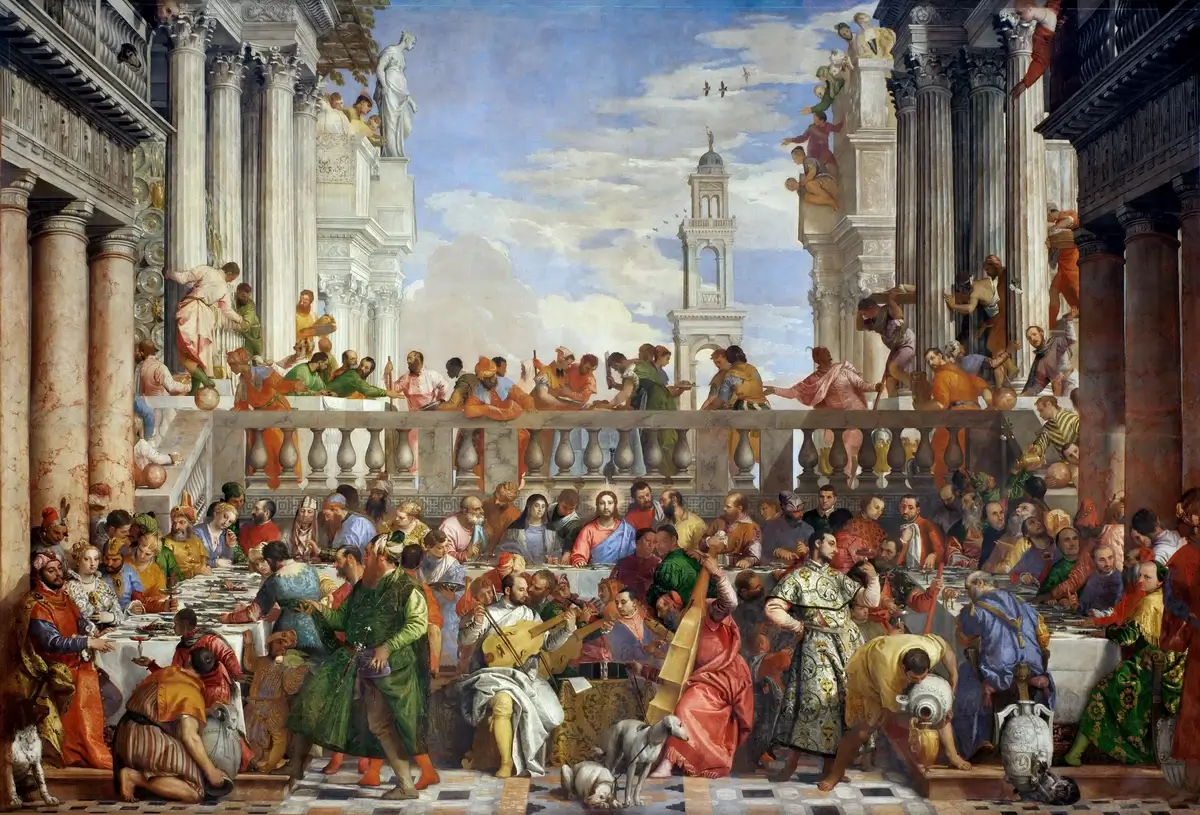
Paolo Veronese, “The Wedding at Cana”, 1563. Image: Wikimedia Commons
Legacy and Influence
Veronese’s legacy is his unparalleled ability to combine narrative storytelling with visual splendor. His use of vibrant colors, luminous shadows, and his integration of figures within architectural settings have been lauded for their artistic brilliance. Despite some criticism for not delving into profound human emotions, Veronese’s works are celebrated for their elegance, narrative complexity, and chromatic brilliance. His influence extends to many of the greatest artists, including Rubens, Watteau, Tiepolo, Delacroix, and Renoir.
14. Masaccio (Tommaso di Giovanni): The Early Renaissance Revolutionary
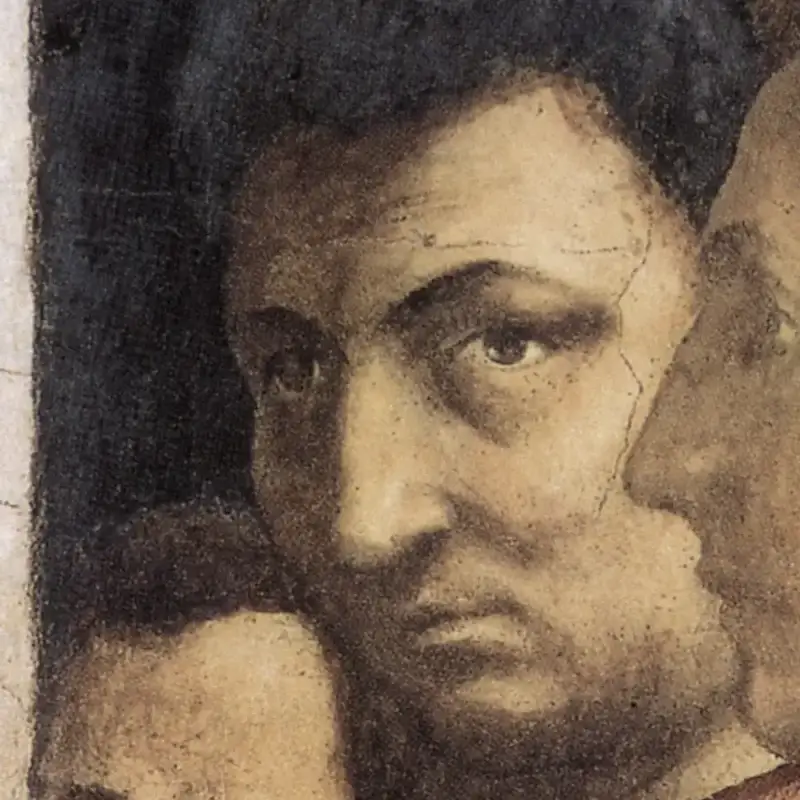
Tommaso di Giovanni, known as Masaccio, born on December 21, 1401, in San Giovanni Valdarno near Florence, Italy, was a transformative figure in the Early Renaissance. Despite a brief career, Masaccio’s innovative approach to painting marked a radical departure from the Gothic style, setting the stage for the Renaissance’s artistic developments.
Artistic Innovations and Key Works
Masaccio’s artistry was characterized by his realistic portrayal of figures, the use of perspective, and his ability to convey deep emotions. His frescoes in the Brancacci Chapel in Florence, particularly “The Tribute Money,” are notable for their use of linear and atmospheric perspective, directional light, and chiaroscuro, which brought a sense of realism previously unseen.
His depiction of Adam and Eve being expelled from the Garden of Eden broke new ground by focusing on the emotional weight of the scene, setting him apart from the expressionless gravity of medieval depictions. This emotional realism, combined with his study of classical sculpture, contributed to a more humanistic representation in art.

Masaccio, “The Tribute Money”, 1425. Image: Wikimedia Commons
Legacy and Influence
Masaccio’s influence on the art world was profound. His use of perspective and realism in portraying human figures significantly impacted Renaissance art and later artists. His works have been studied and revered for their groundbreaking approach, demonstrating a mastery of space and perspective that captivated both his contemporaries and future generations of artists.
Masaccio’s life, tragically cut short in the summer of 1428 in Rome, left an indelible mark on the history of art. His revolutionary techniques and naturalistic style were pivotal in ushering in the new artistic era of the Renaissance.
15. Fra Angelico: A Pious Painter of the Early Renaissance
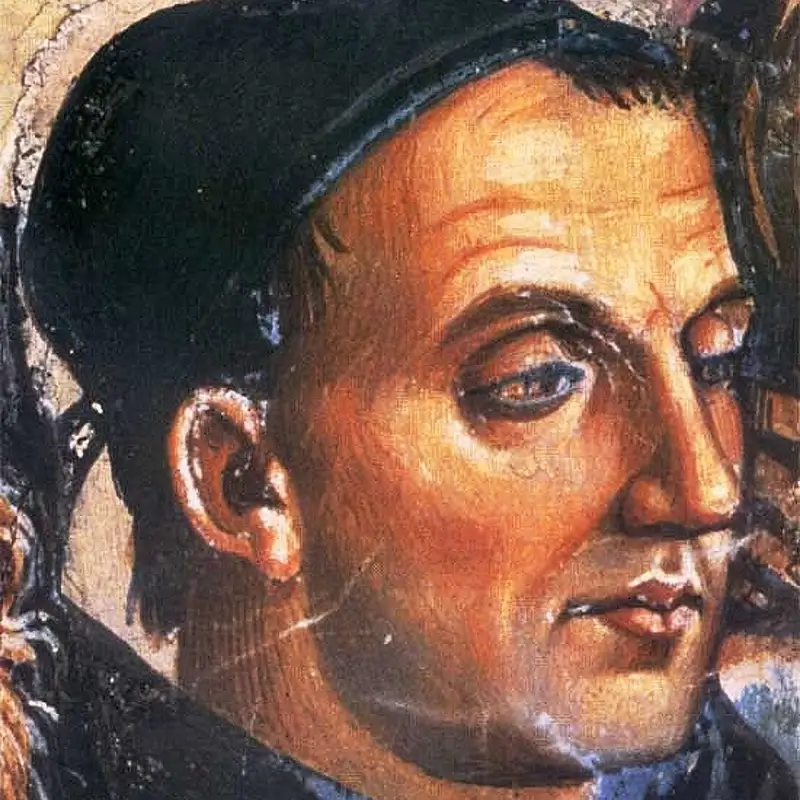
Fra Angelico, born Guido di Pietro around 1395 in Vicchio, near Florence, was a Dominican friar and an Early Renaissance Italian painter. Known for his serene and devout approach to religious painting, Fra Angelico’s works embody a remarkable fusion of spirituality and artistic innovation.
Baptism into Art and Faith
Initially known as Guido di Pietro, Fra Angelico began his career as a lay painter before embracing a religious life between 1420 and 1422, taking the name Fra Giovanni da Fiesole upon joining the Dominican Order in Fiesole. His early works, profoundly influenced by the teachings of Giovanni Dominici and Lorenzo Monaco, were marked by a clear, painstaking execution and a vibrancy that spiritualized the figures in his paintings.
Innovations in Fresco and Altarpiece Painting
Fra Angelico’s artistry flourished during his time at the San Marco convent in Florence, where he painted frescoes and altarpieces that were revolutionary for their time. His “Annunciation of Cortona,” “Fiesole Altarpiece,” and “San Marco Altarpiece” are notable for their use of perspective and luminosity. In these works, Angelico demonstrated an extraordinary ability to create depth and spiritual significance, setting the stage for later Renaissance masters.
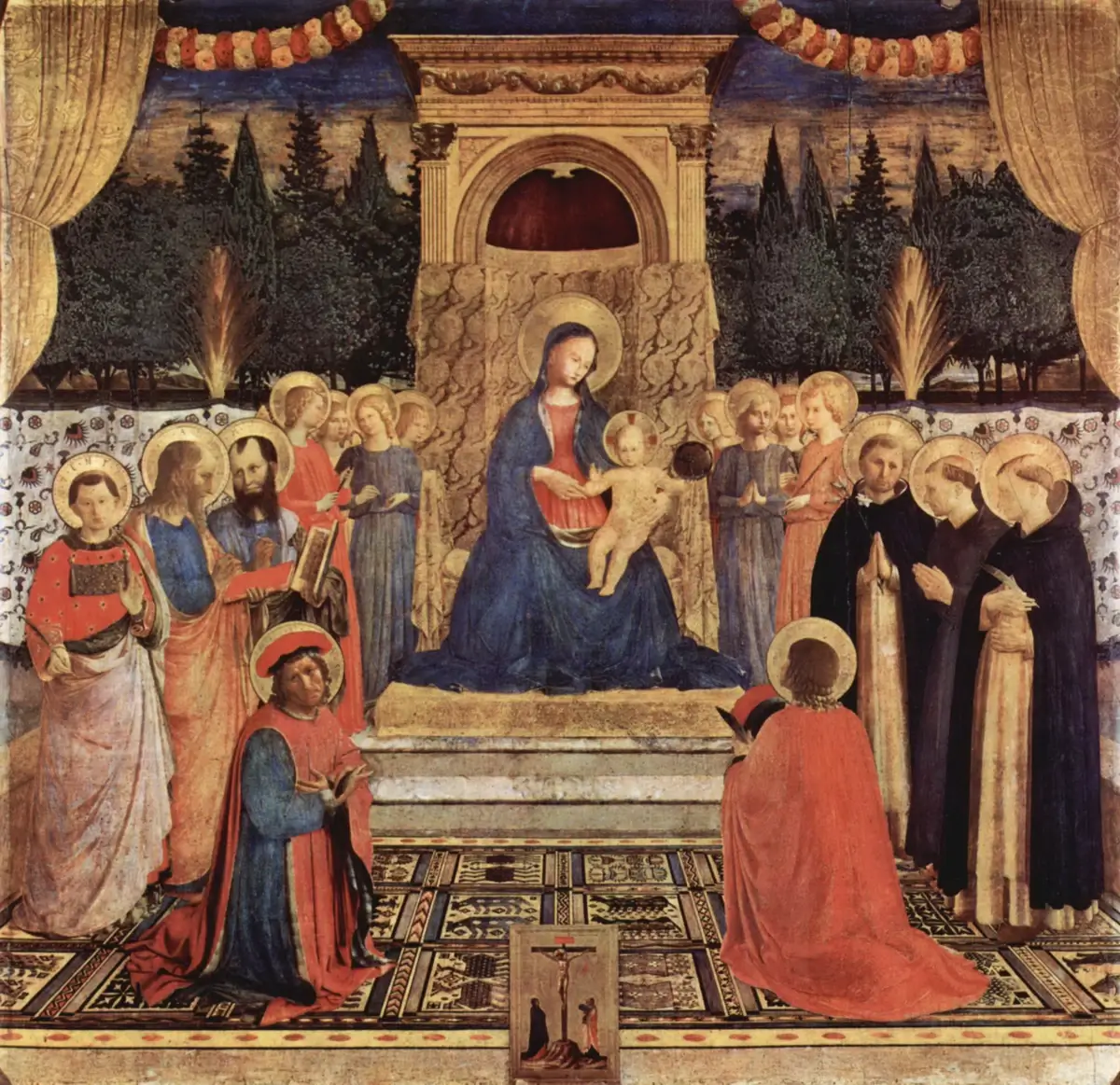
Fra Angelico, “San Marco Altarpiece”, 1443. Image: Wikimedia Commons
The San Marco Legacy
In 1436, Fra Angelico moved to the newly built convent of San Marco in Florence. His works there, commissioned by Cosimo de’ Medici, include the famous “Annunciation” fresco. These paintings are characterized by their luminous quality and devotional nature, significantly impacting the art of the Early Renaissance.
A Saintly Artist
Fra Angelico’s life was a blend of artistic genius and deep piety. He was beatified by Pope John Paul II in 1982, recognizing his holiness and contribution to religious art. His works, characterized by their gentle, serene figures and bright, clear colors, continue to be revered for their spiritual depth and artistic merit.
FAQ
Who is the most famous artist in Italy?
The title of the most famous Italian artist is often attributed to Leonardo da Vinci, recognized globally for his profound impact on art and science. His masterpieces like “The Last Supper” and “Mona Lisa” continue to hold iconic status in the world of art.
Who is the highest selling Italian artist?
The highest selling Italian artist in terms of the price paid for a single painting is Leonardo da Vinci. His painting “Salvator Mundi” sold for approximately $450.3 million in November 2017, making it the highest price paid for any painting at that time.
Who is the father of Italian art?
Giotto di Bondone is often considered a pivotal figure in the deviation from the Byzantine style and is cited as one of the first Renaissance artists. His approach to painting life in actuality and incorporating three-dimensional forms and accurate human emotions set the stage for the Renaissance in Italy.
Who was a famous artist in Rome?
Raphael, born Raffaello Sanzio da Urbino, was one of the most famous Italian artists of the High Renaissance period and was notably active in Rome. He was acclaimed for his works in the Vatican Palace, including “The School of Athens” and the “Sistine Madonna”.
Who is the famous artist in Florence?
Sandro Botticelli, born Alessandro di Mariano di Vanni Filipepi, is a renowned artist from Florence, particularly famous for his mythological works like “The Birth of Venus” and “Primavera.” His style significantly influenced European art, echoing the vitality and beauty of the Renaissance era.


